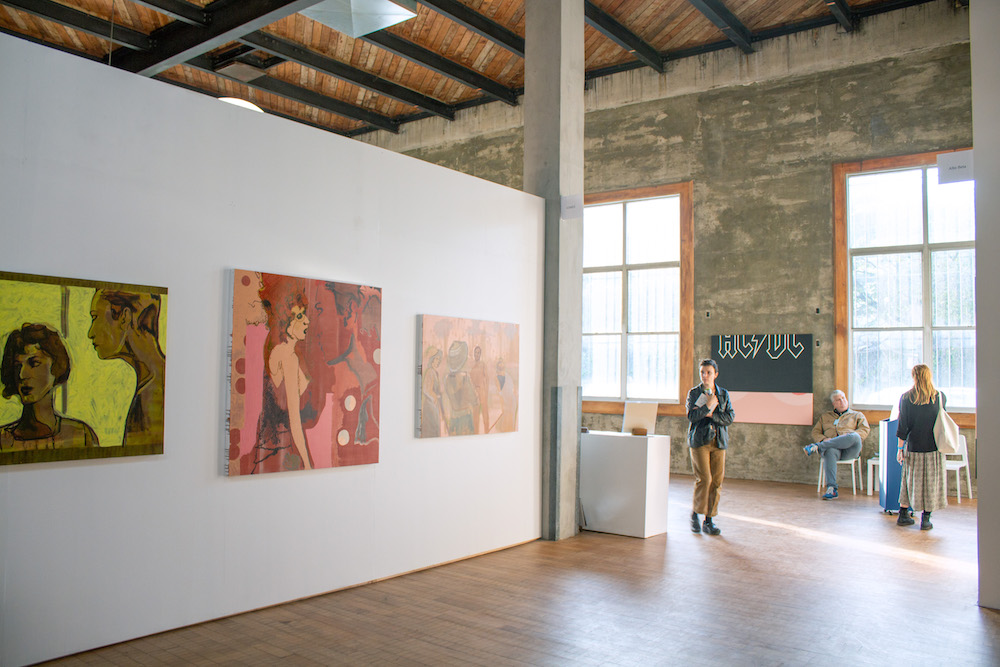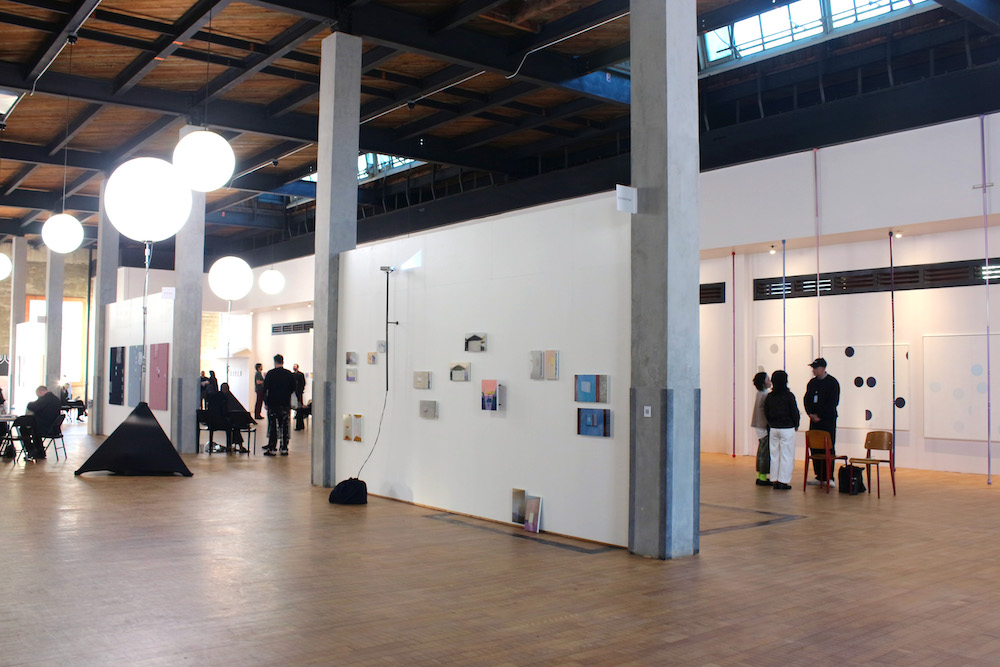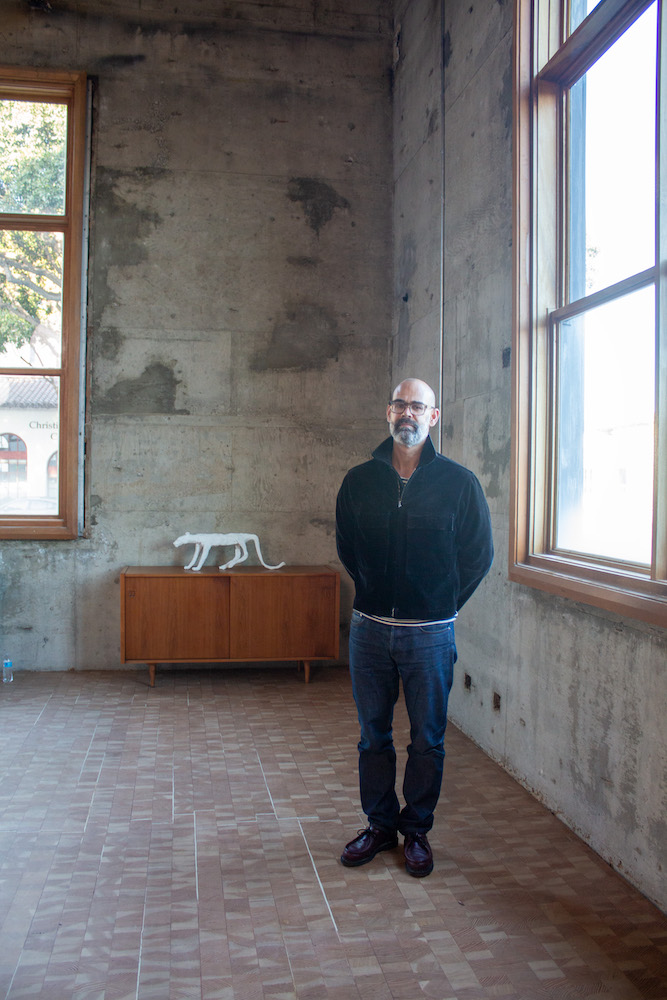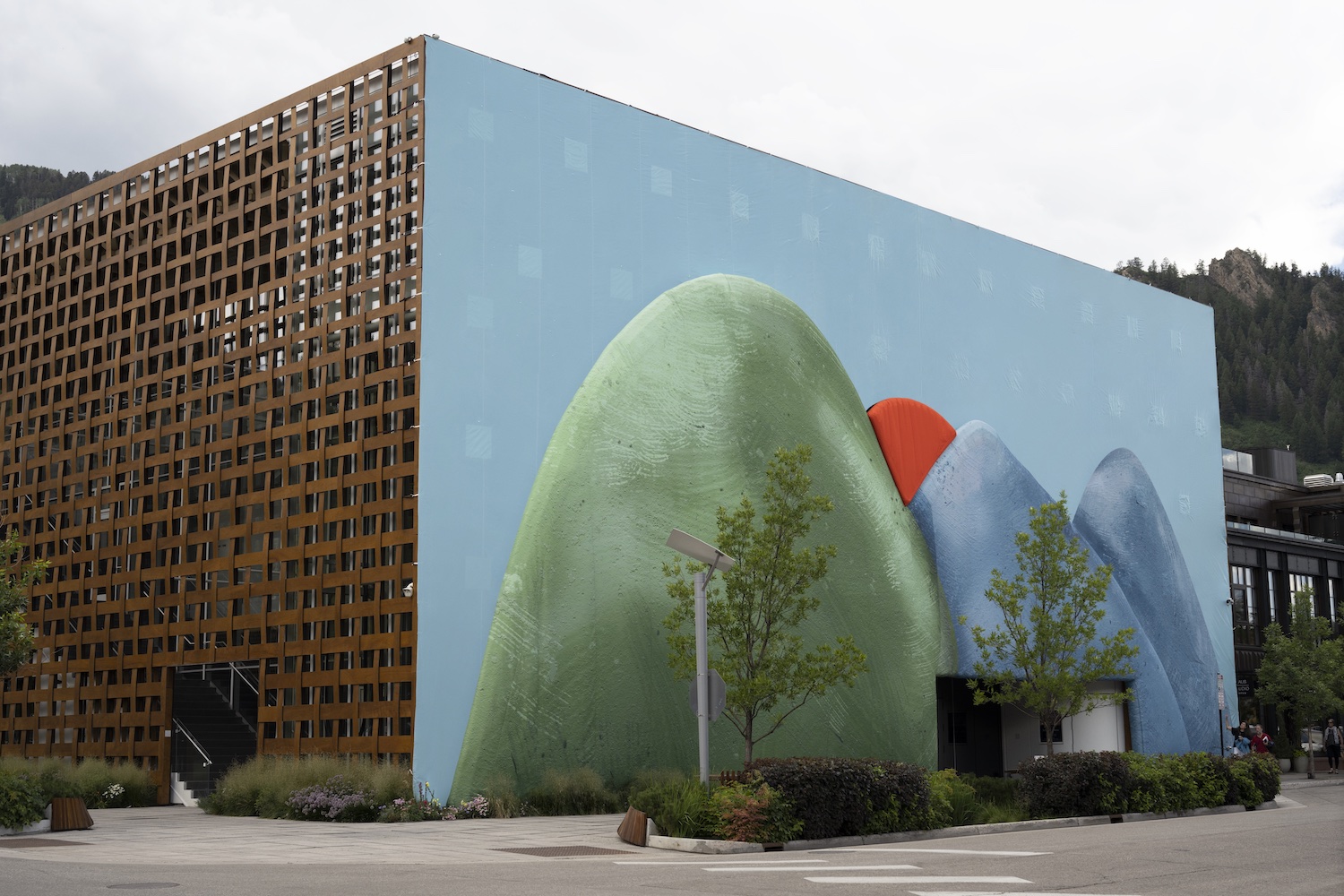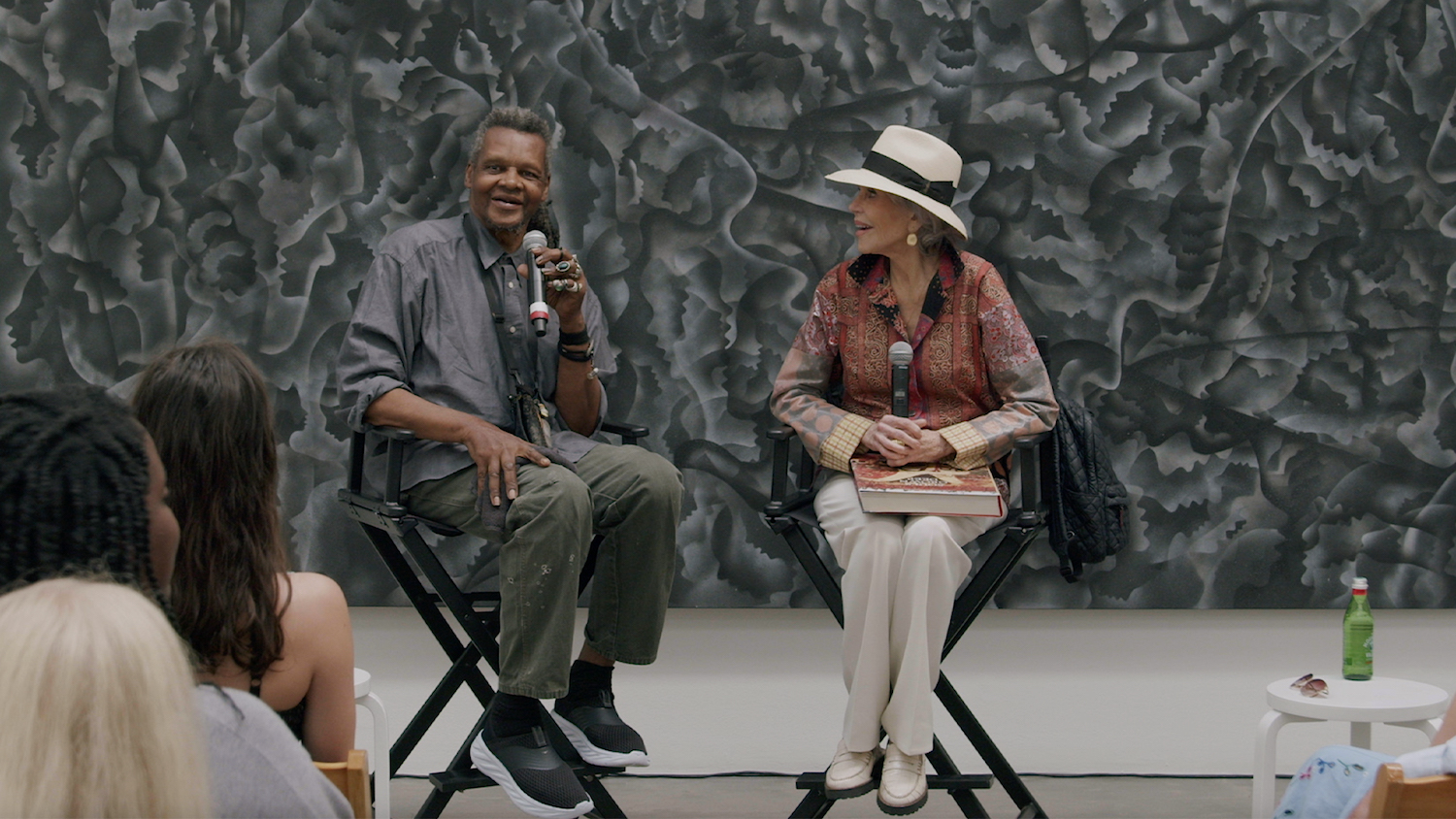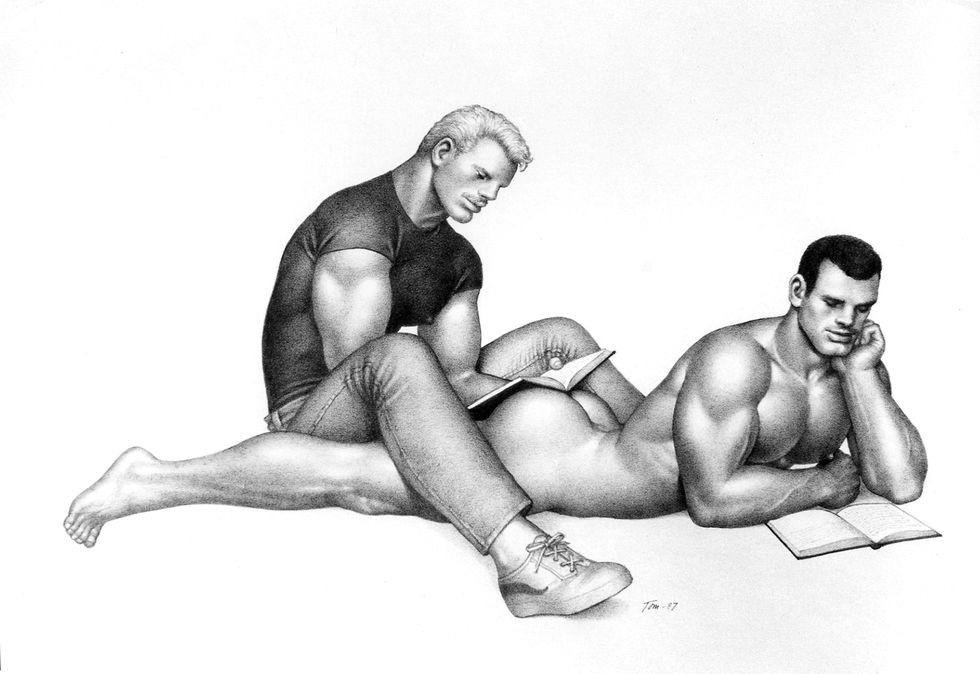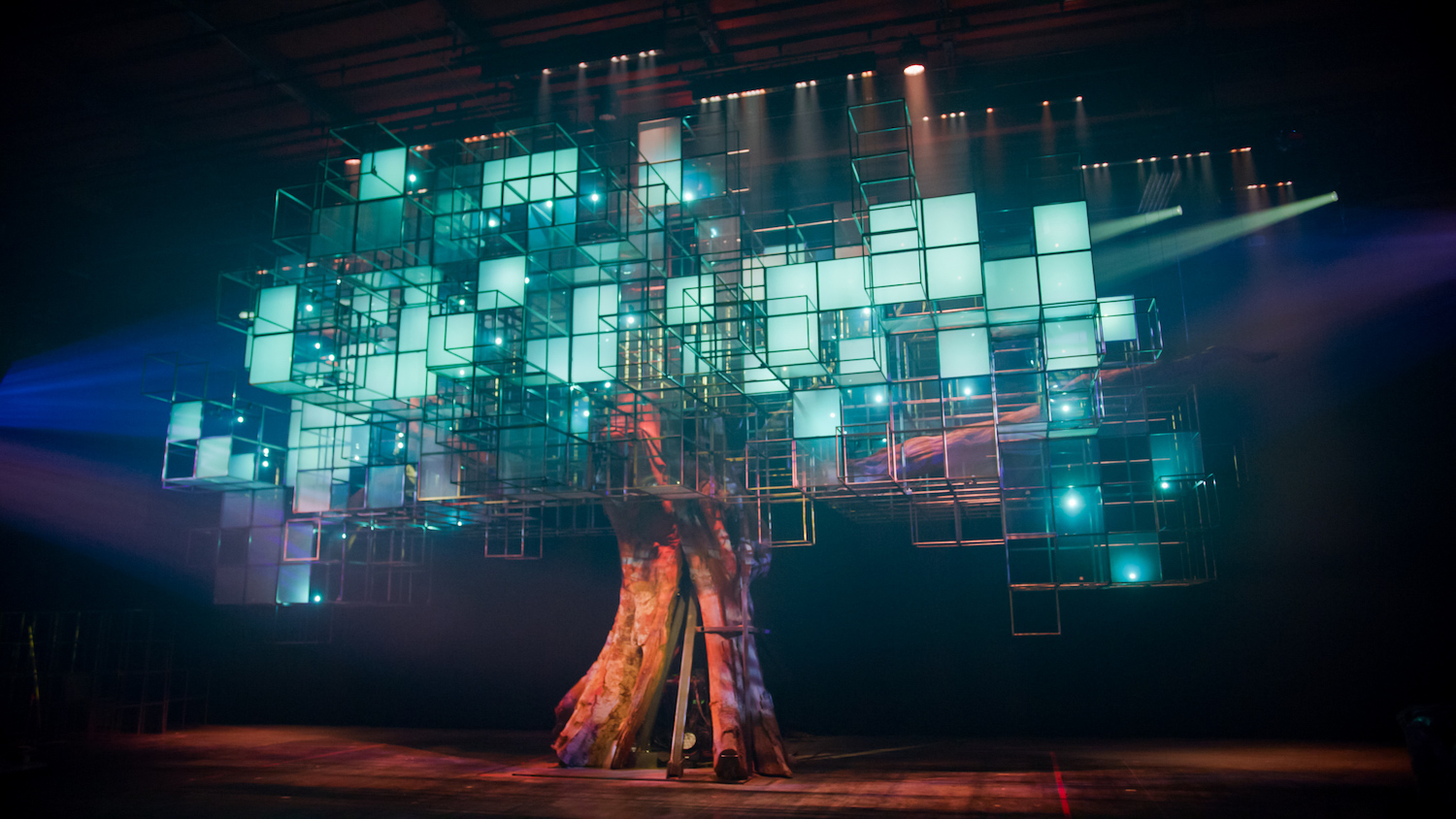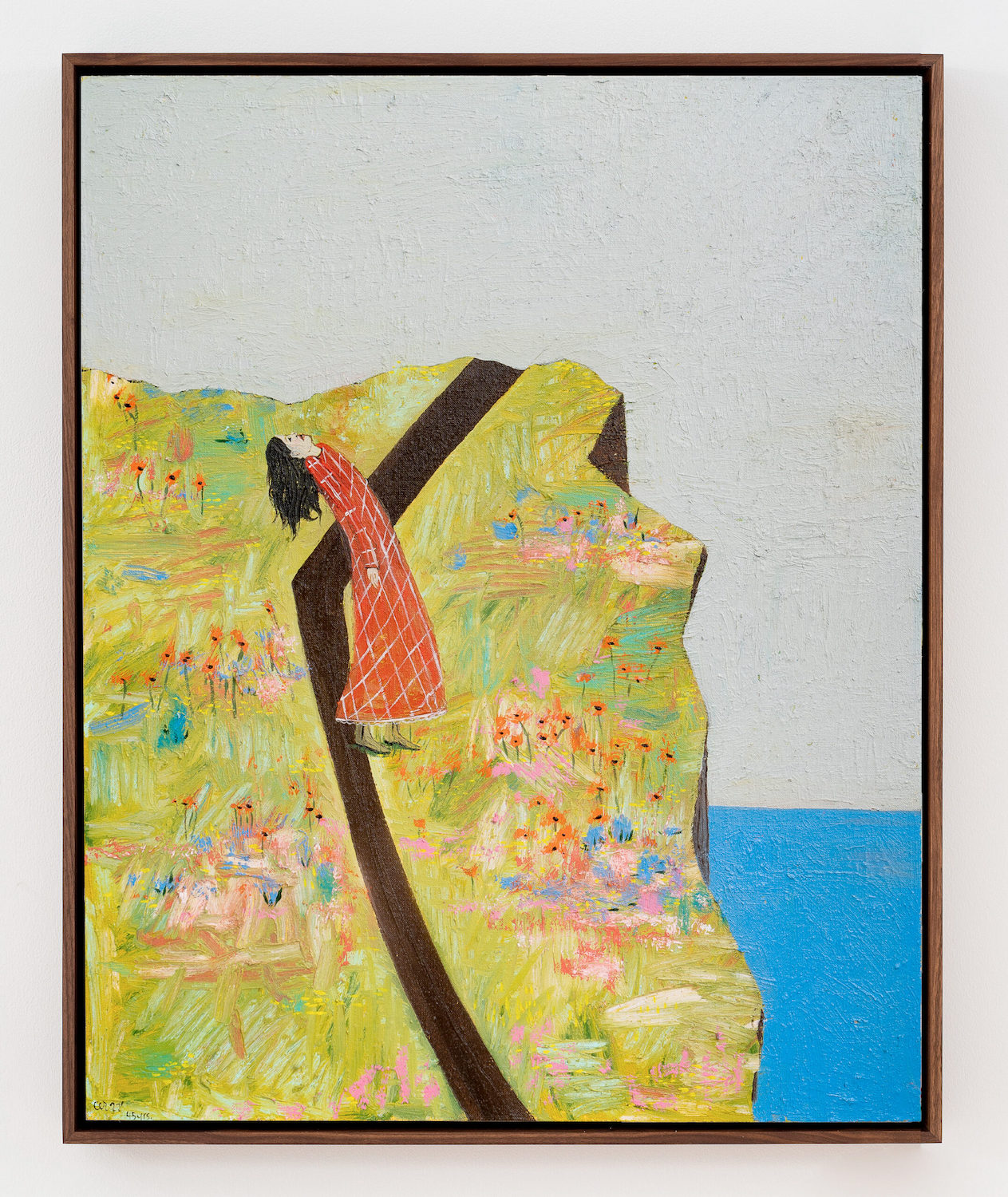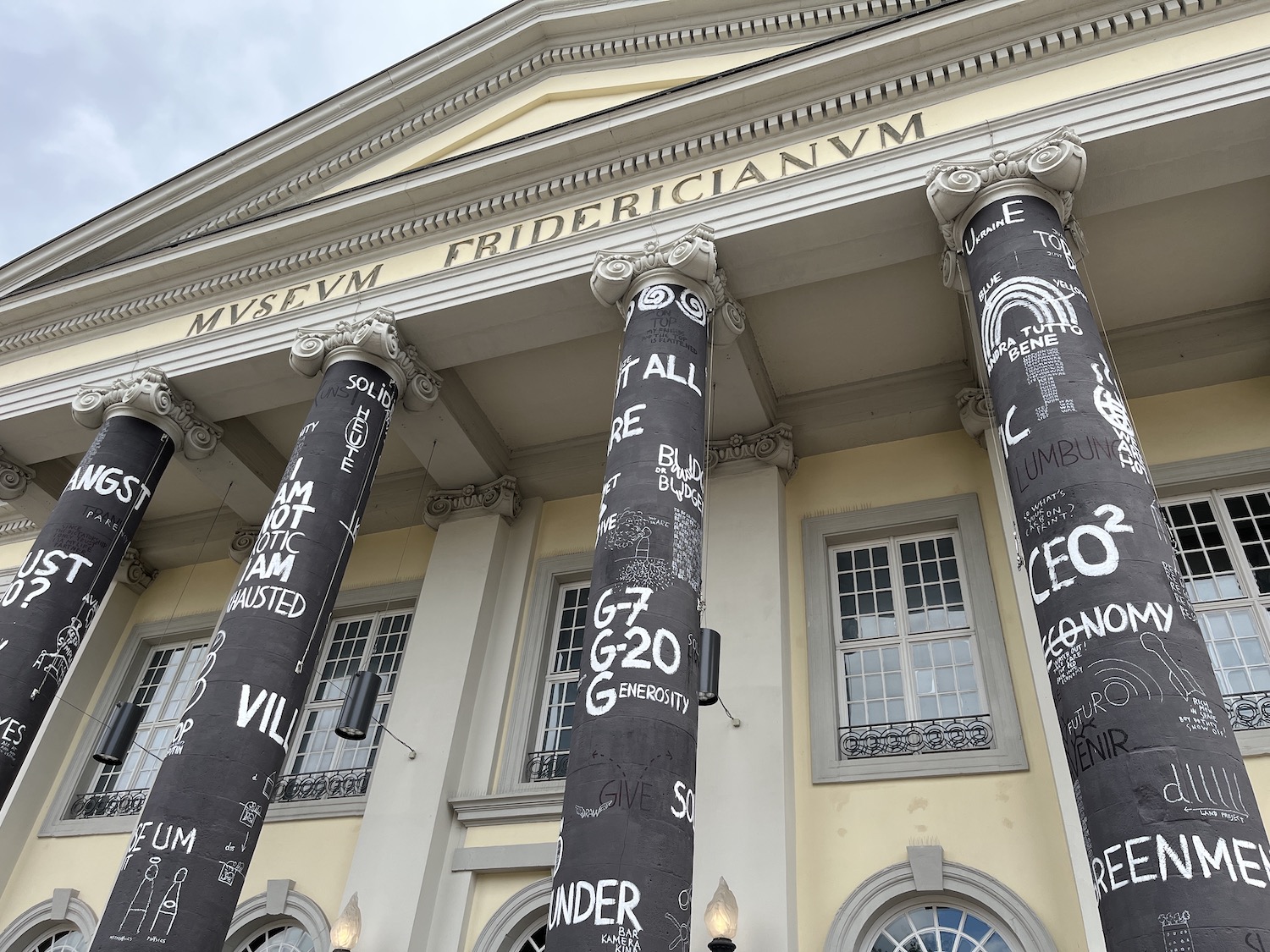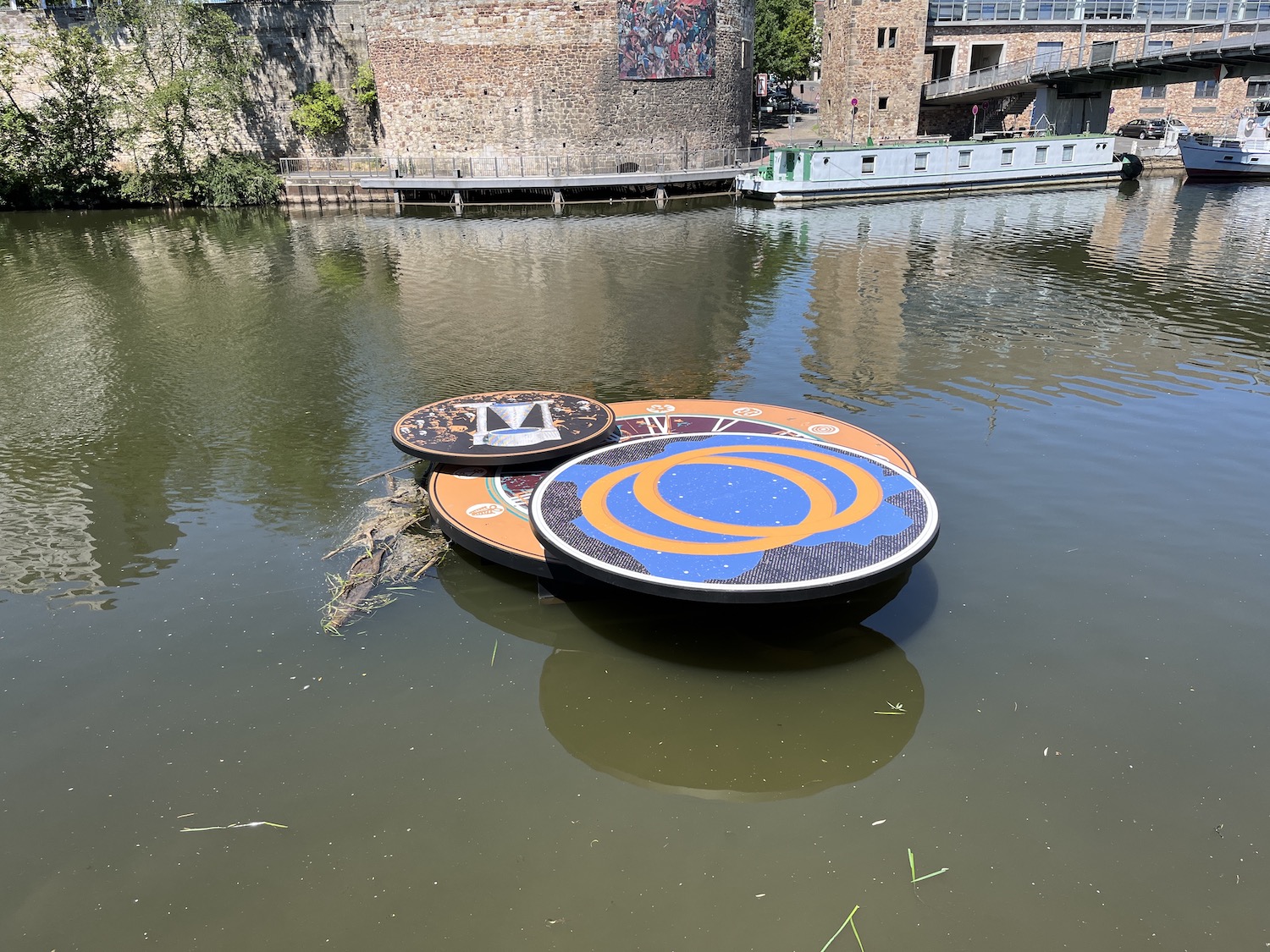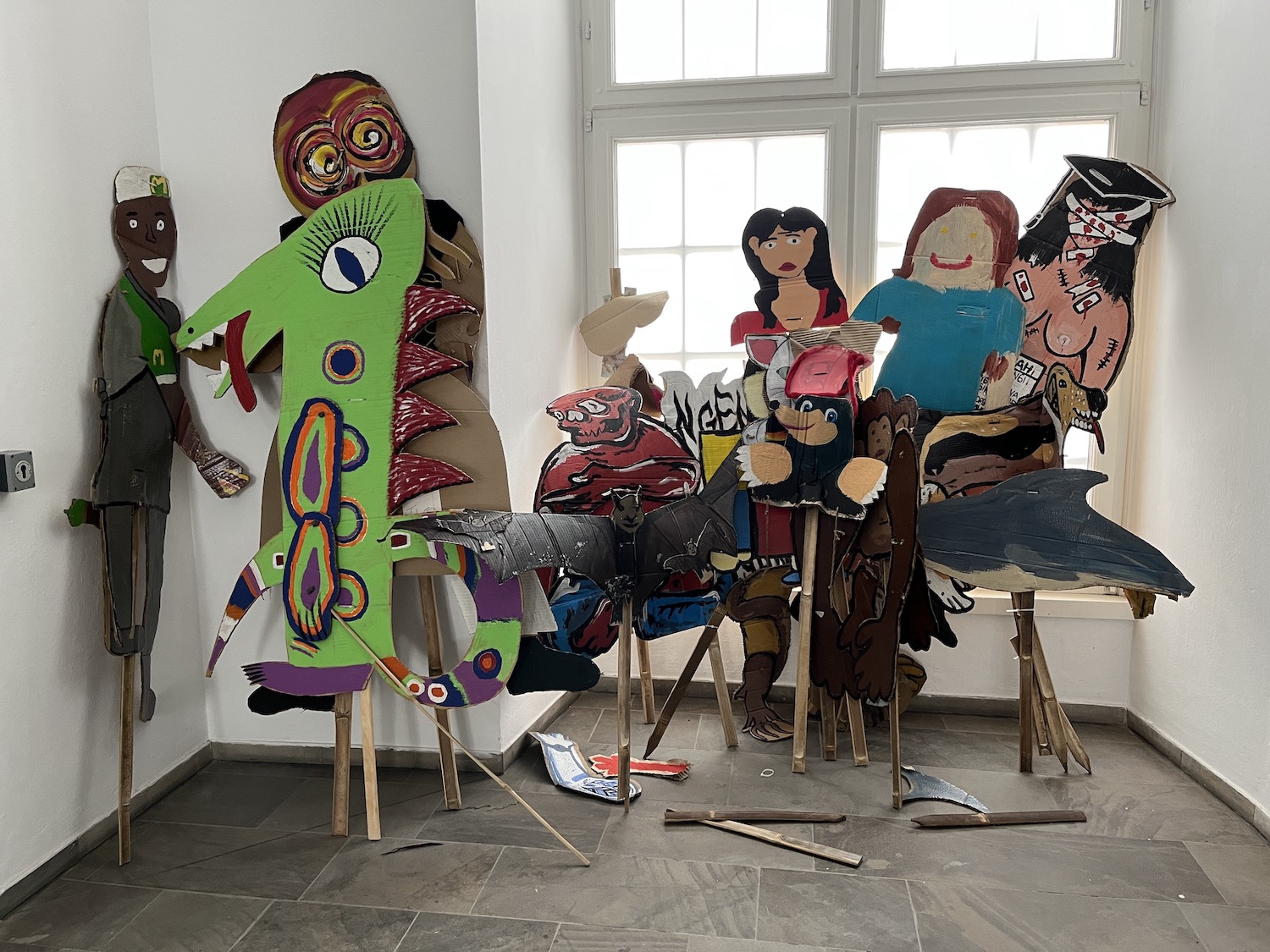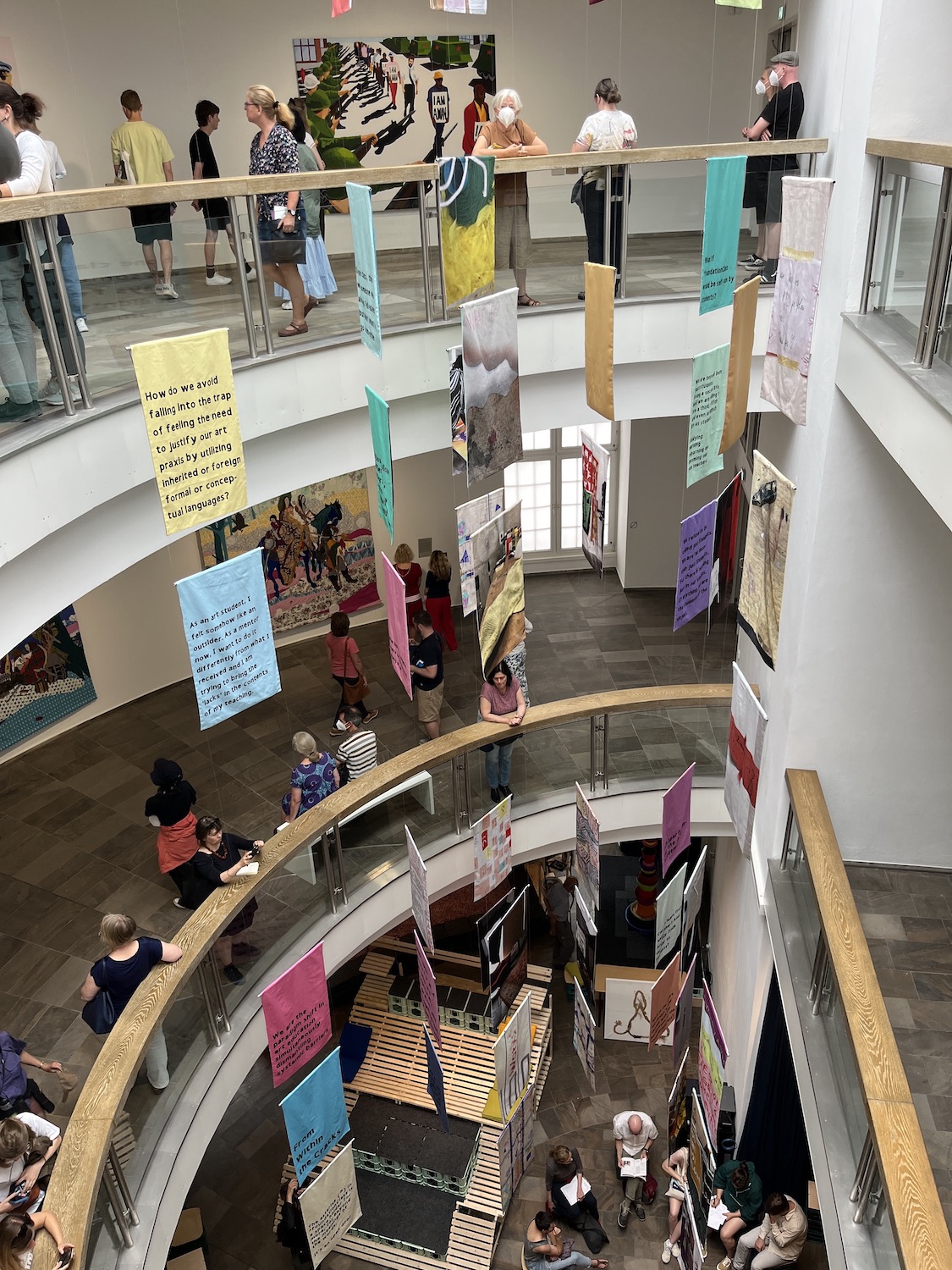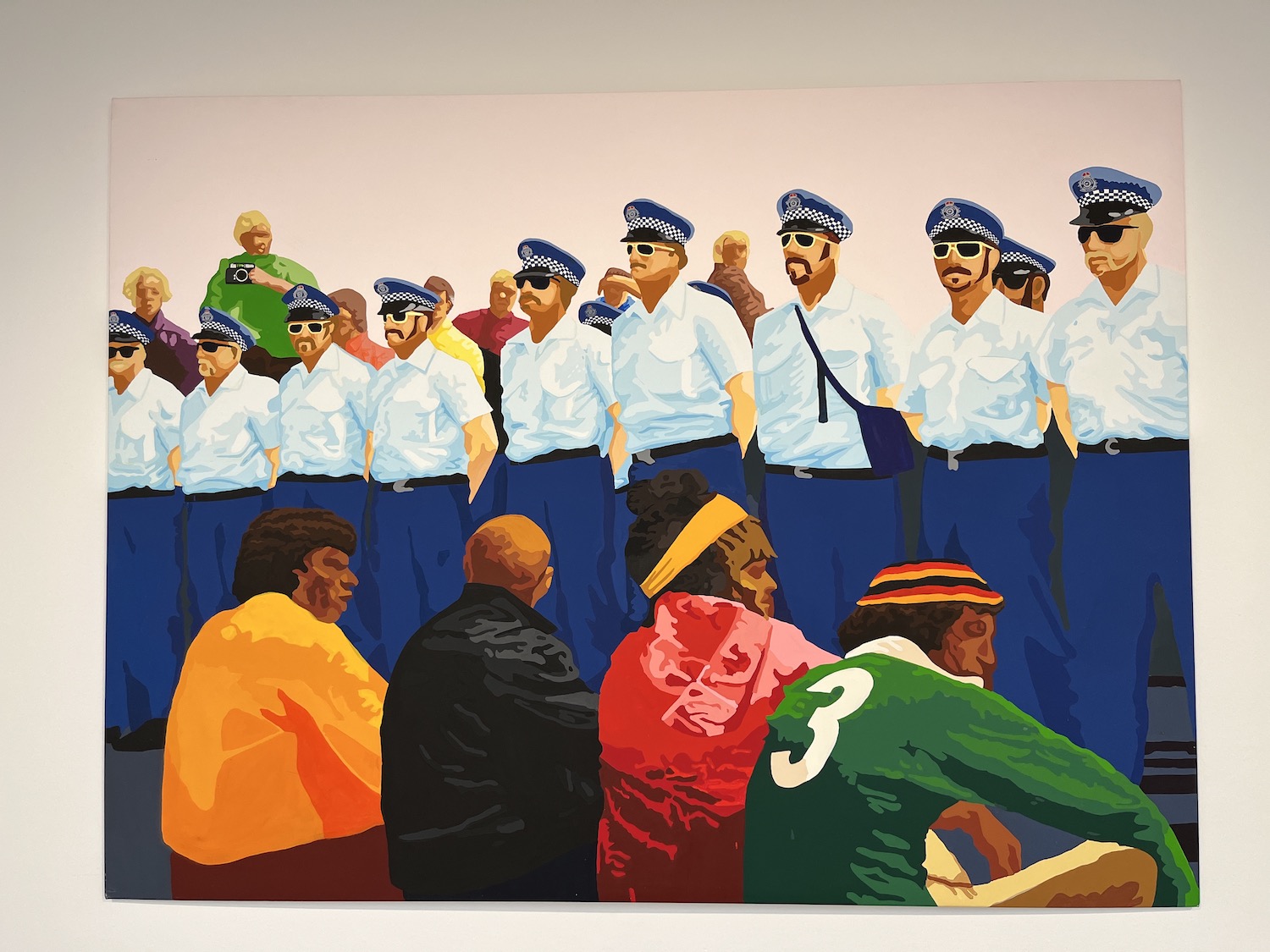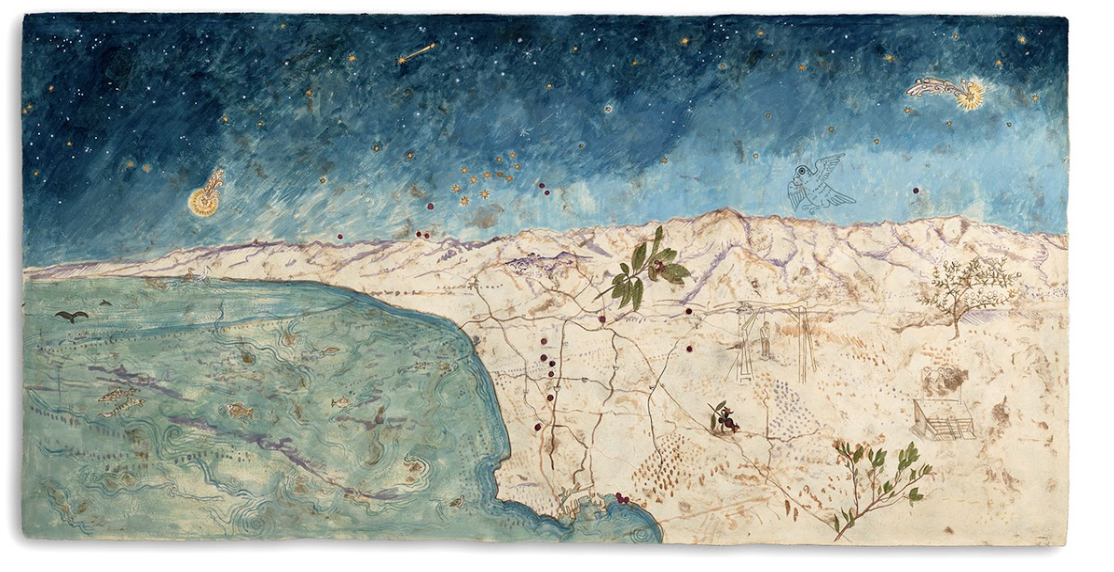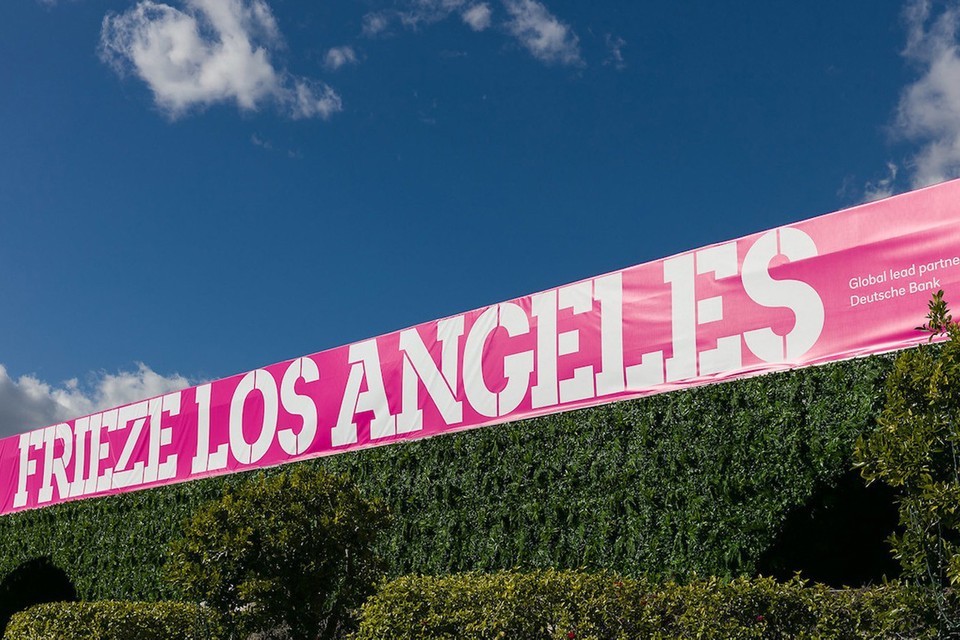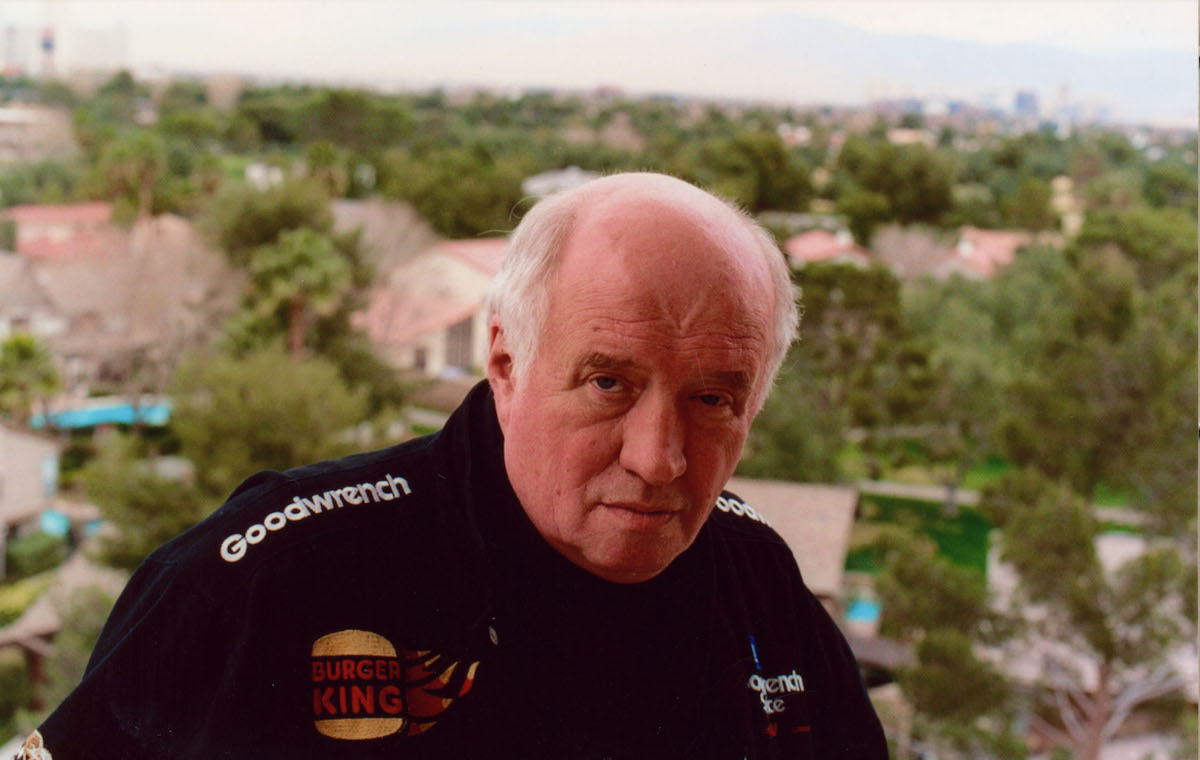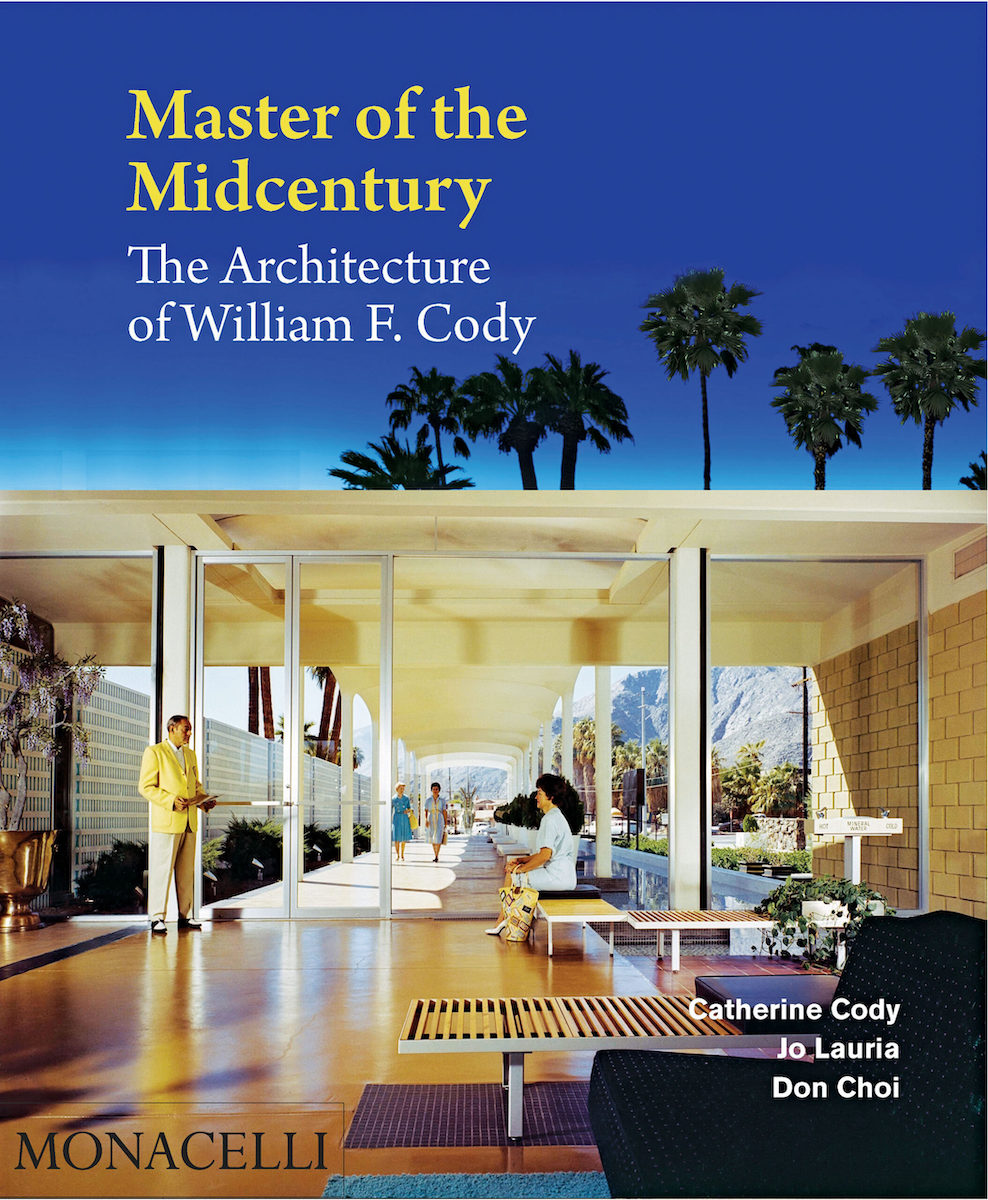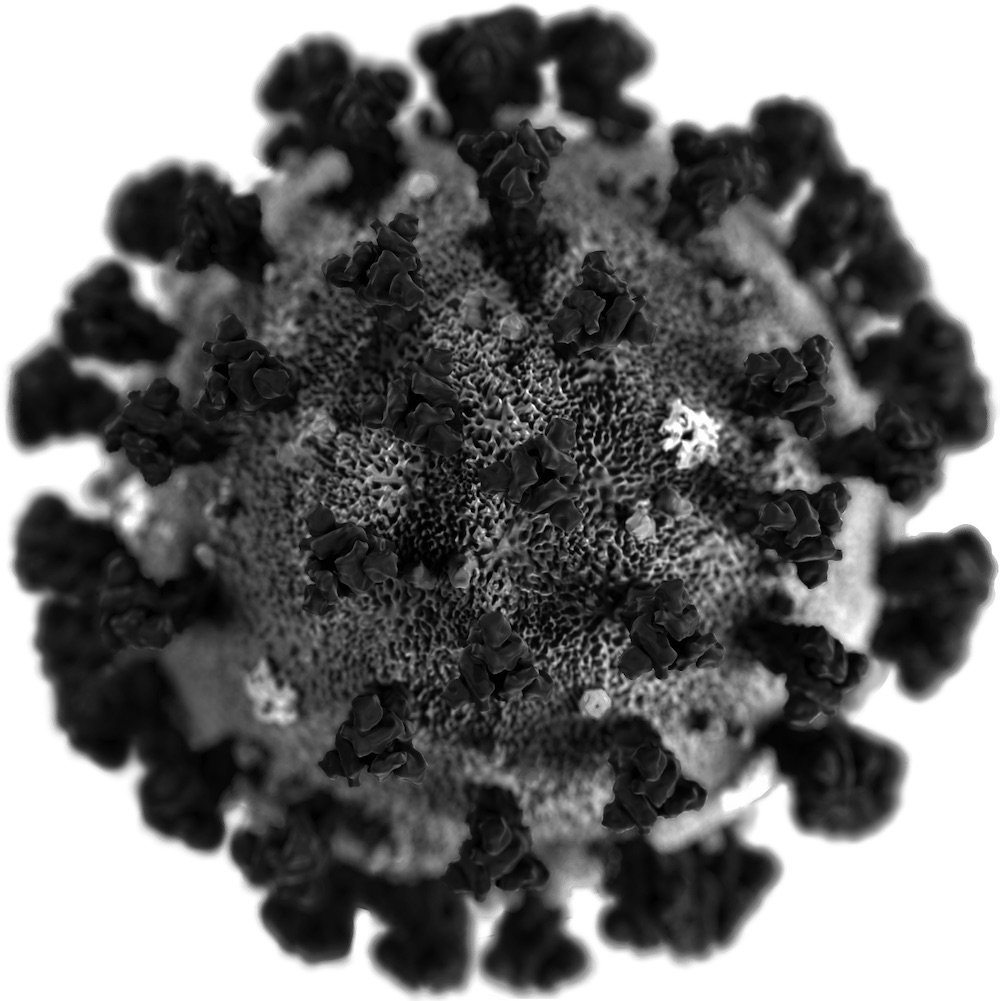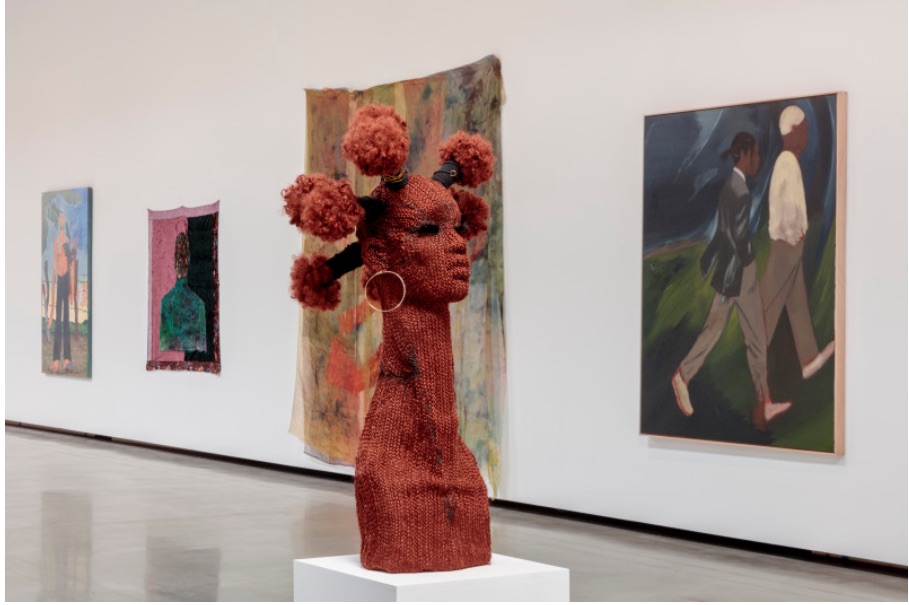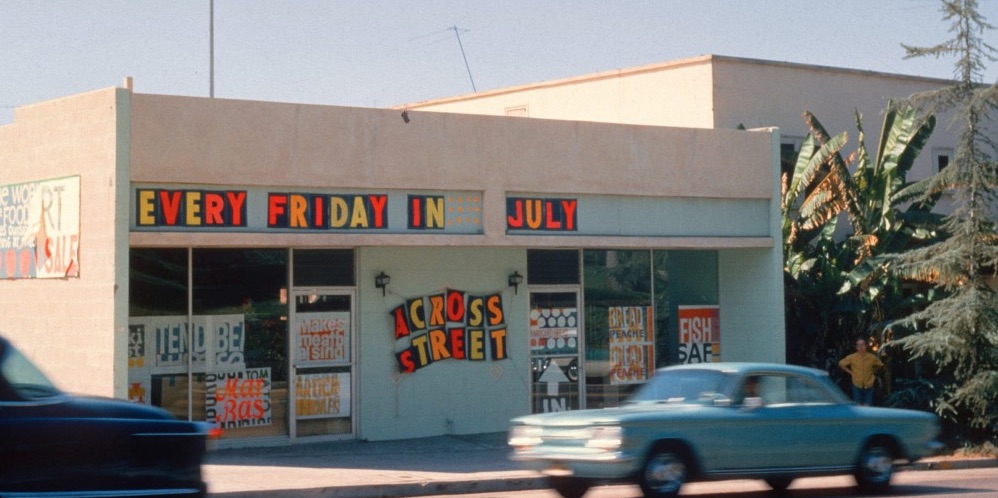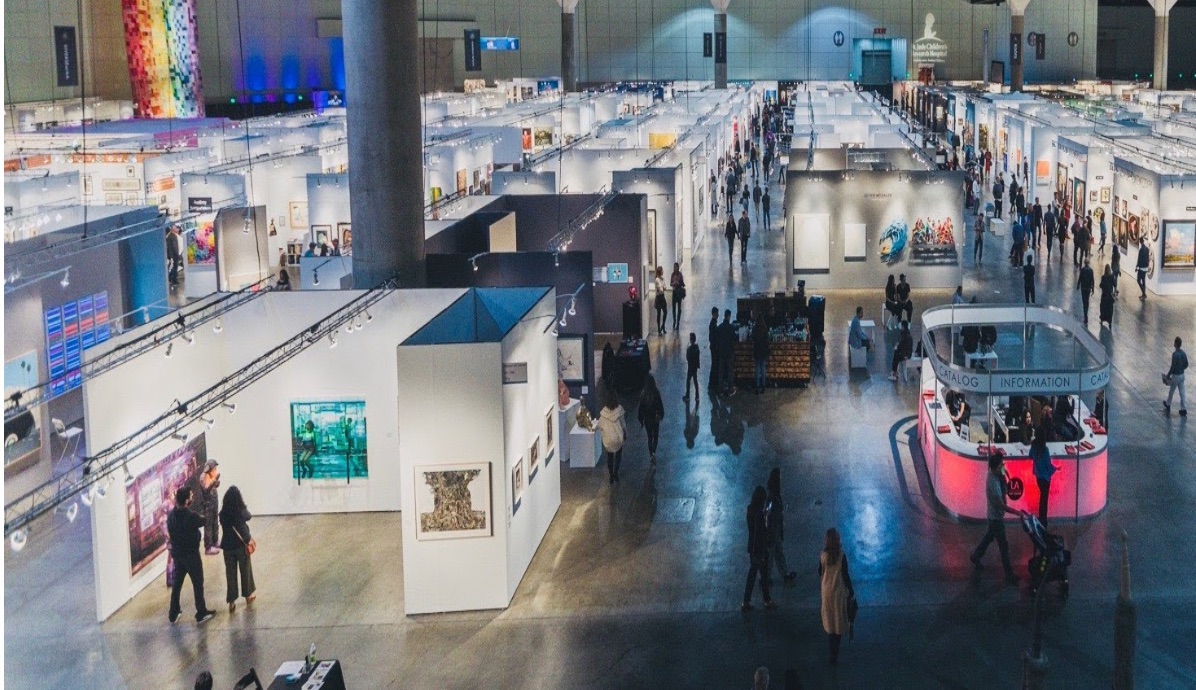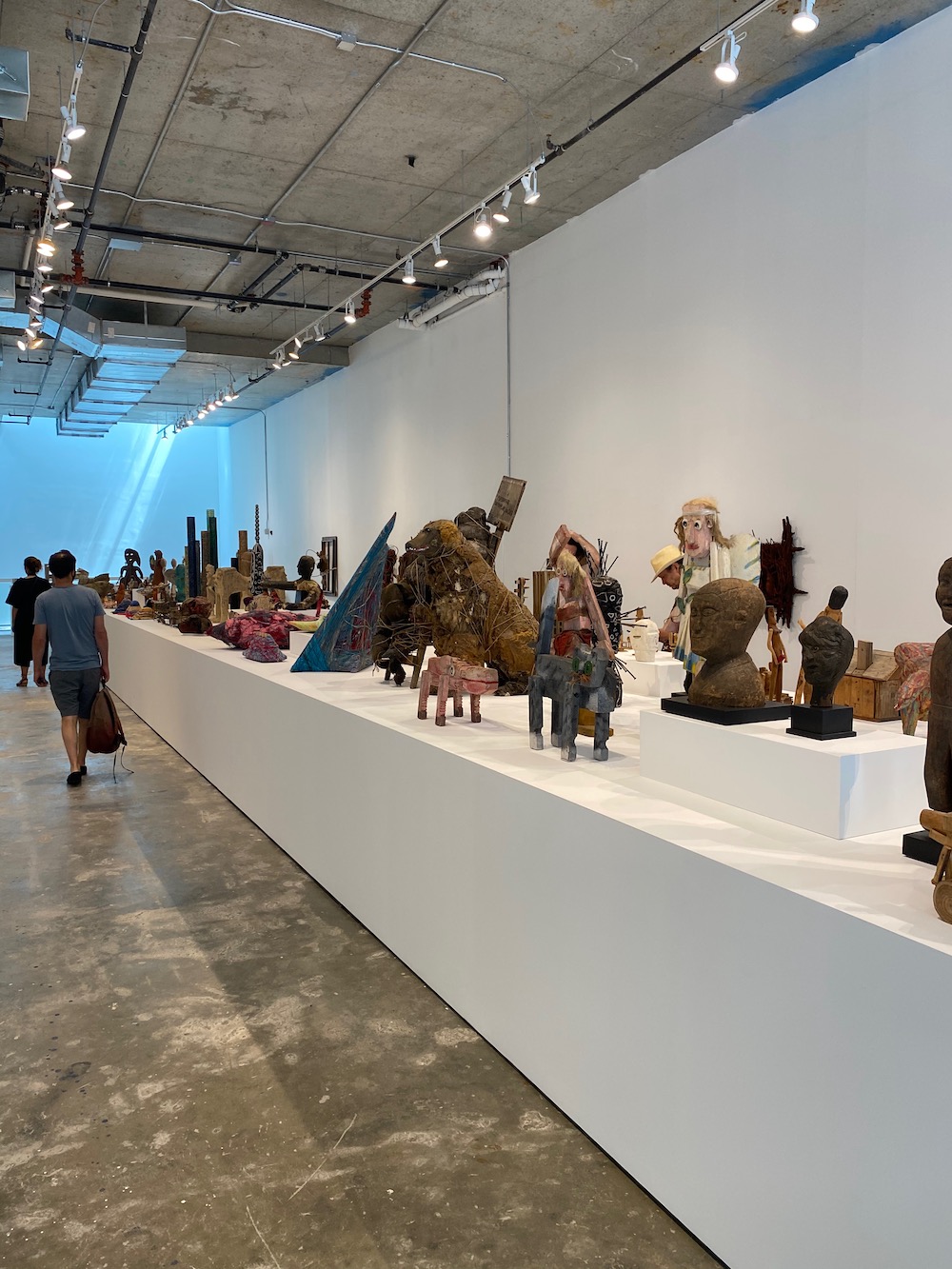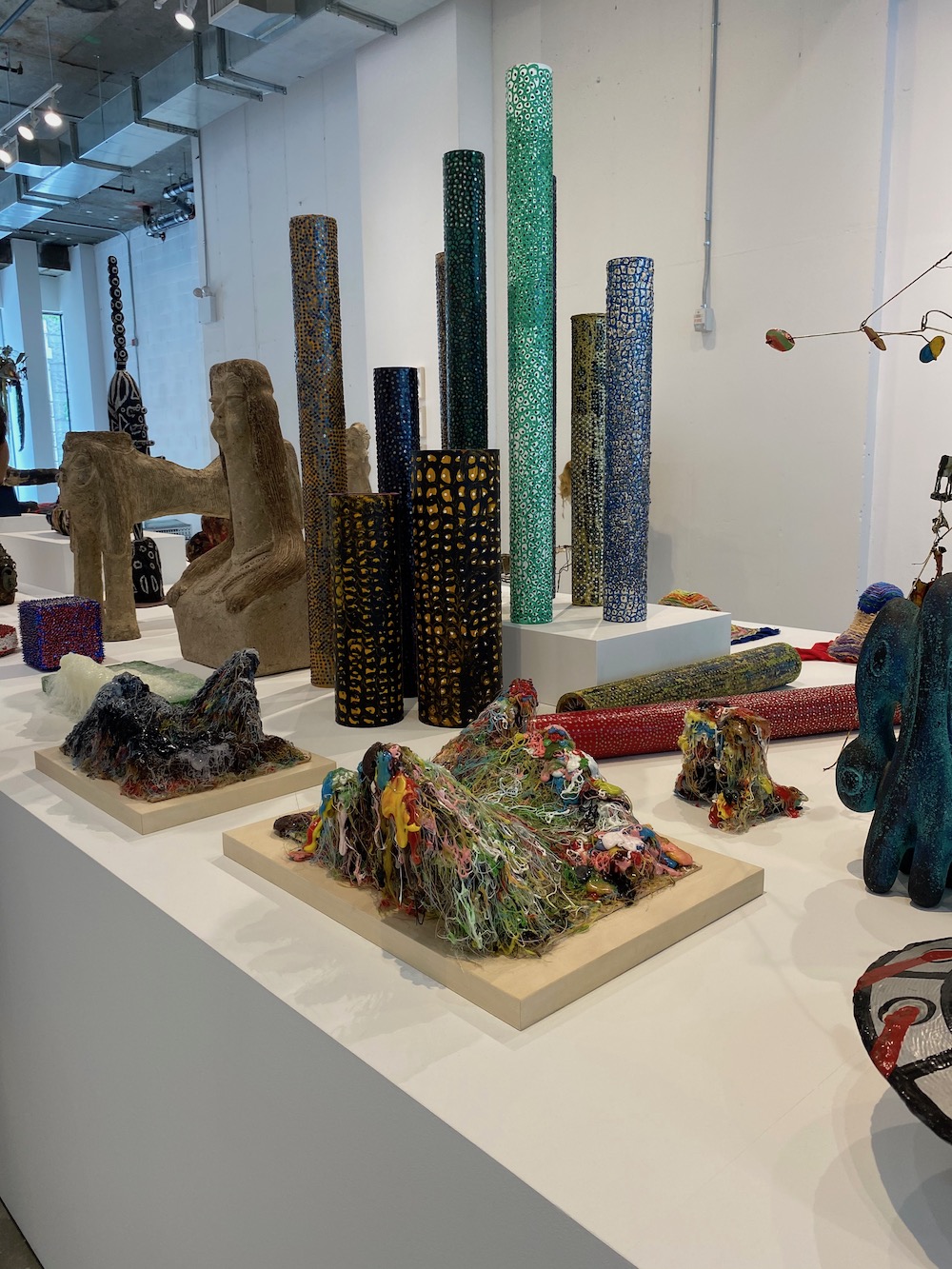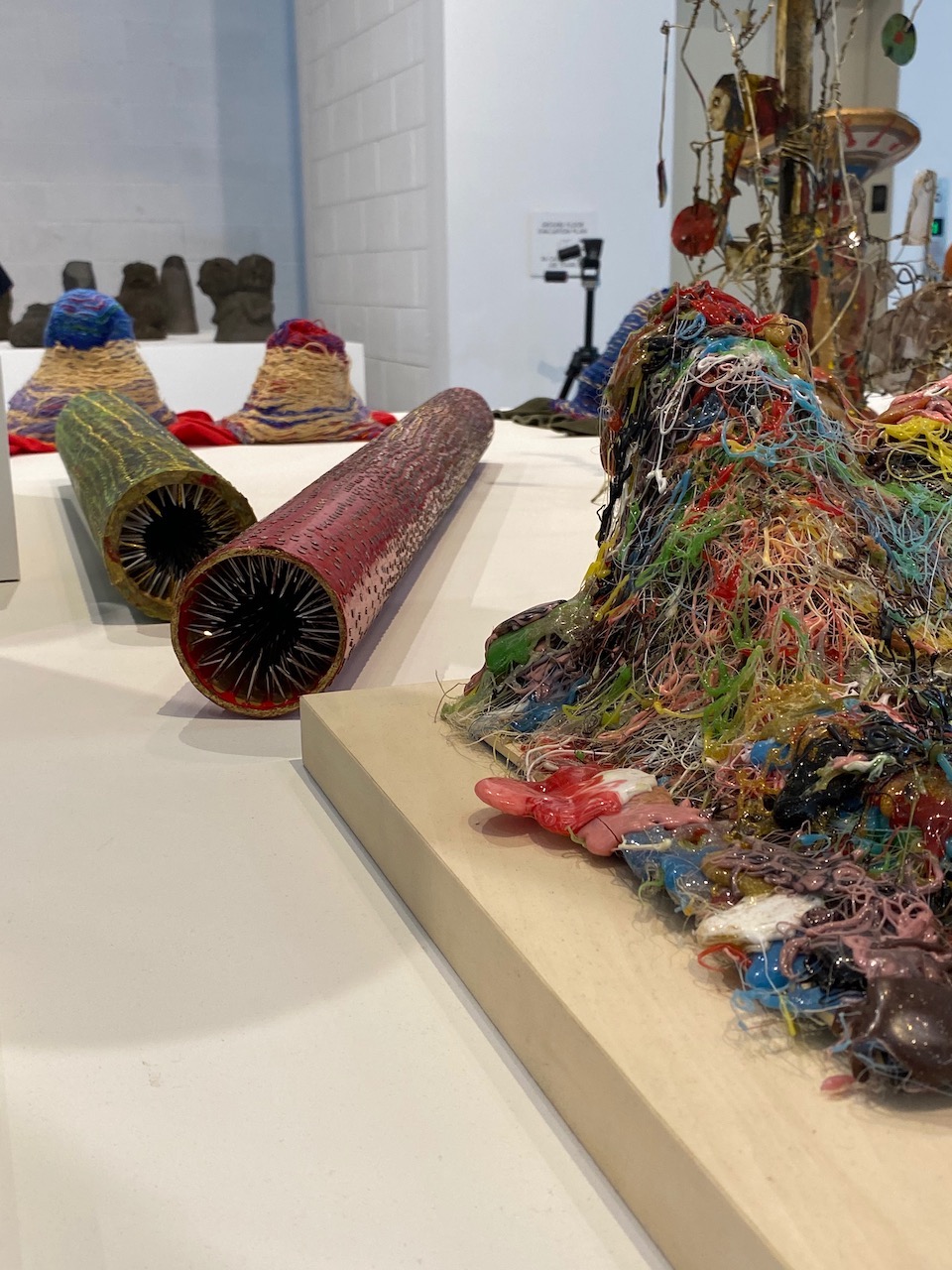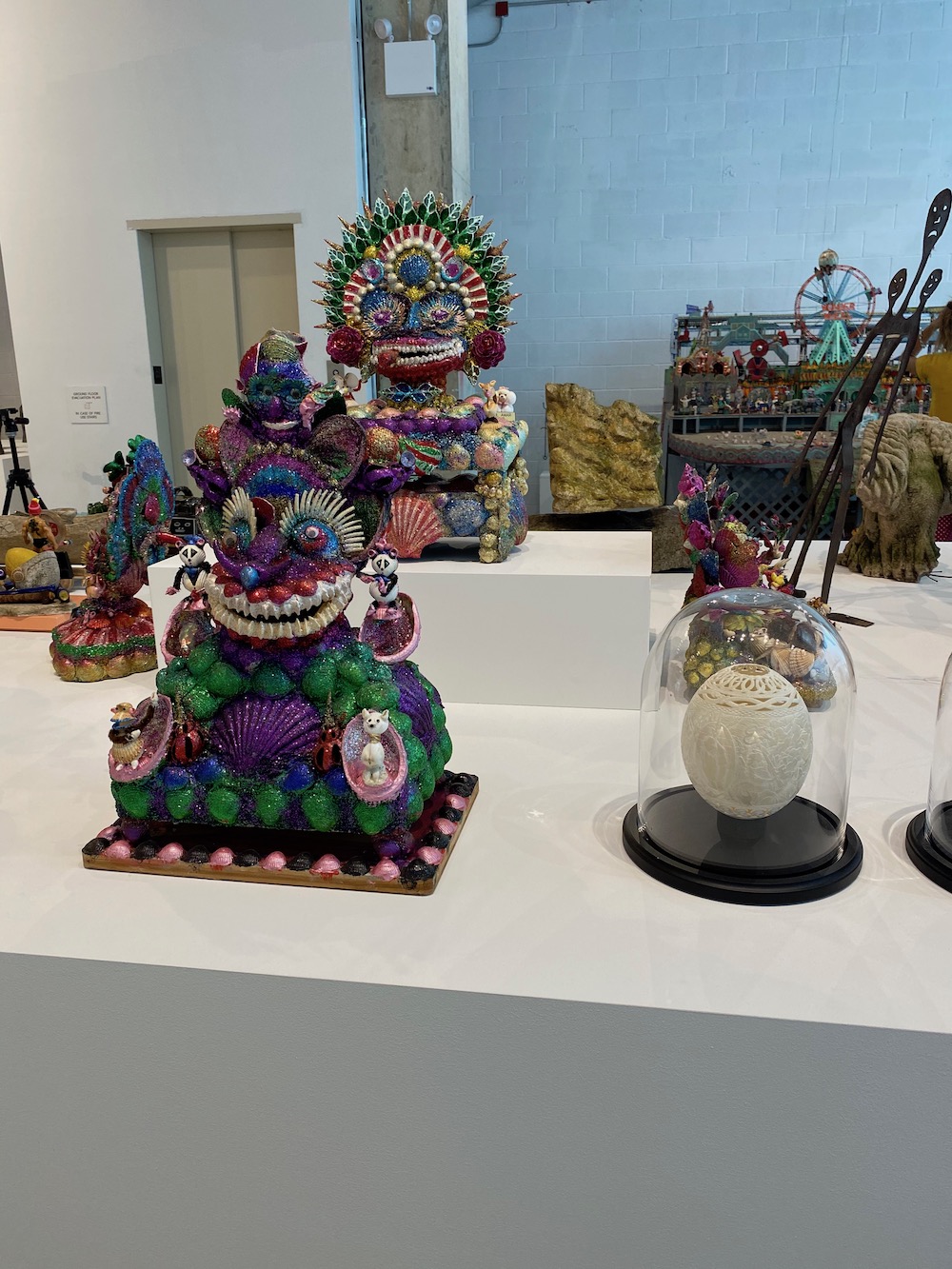Your cart is currently empty!
Tag: art fair
-

FAIR AND SQUARE
Post-Fair Brings Equitability to Santa MonicaLast week, during Los Angeles Art Week, I saw James Franco everywhere. I saw James Franco at Felix at the Hollywood Roosevelt, where the David Hockney-painted pool was closed because a man had had a heart attack inside it the day before. I saw James Franco at the Karma party at Ghengis Cohen, his trucker hat popping up behind a psychic and very beautiful astrologer. I saw James Franco at Frieze, taking in the valuable wall real estate at the sizable David Zwirner booth. But the first place I saw James Franco smile was at the inaugural Post-Fair in Santa Monica, as Theta gallery founder and director Jordan Barse took him through her exhibition of Tinseltown-themed paintings by Pictures Generation artist Nancy Dwyer. I smiled at the Post-Fair, too.
The Post-Fair, a little jewel box of a fair held at the landmark Santa Monica Post Office building, was founded by Mid-City gallerist Chris Sharp, a dealer with excellent taste and an aptronym for a surname. He decided to start his own fair for a simple reason: Frieze, where the price of a small booth starts at $35,000, is just too expensive. Participating in that fair, or even its somewhat less costly alternative, Felix, can knock out an emerging gallery like Sharp’s, whose business is four years old. He aimed for something more equitable than the established fairs, splitting the cost of renting the post office between 26 galleries (all showing single-artist presentations) for a flat rate of $6,000 each.
“We’re in a moment where things are so difficult,” he says. “Survival feels so precarious and the market’s so weak, so I just wanted to create something where participating in it wasn’t an existential threat to the gallery. Because a lot of the time, when you’re doing these big fairs it’s make or break, just because the costs are so high.”
“To use Marxist terminology,” he says, chuckling, “we’re seizing the means of production.” The name really works.

Image by Artillery staff. Sharp’s fellow gallerists met the idea with enthusiasm. He invited galleries ranging from decades-old, established institutions like Sprüth Magers and PPOW, to far younger galleries, like the Dimes Square-adjacent King’s Leap, and CASTLE, which opened in a Hancock Park apartment less than two years ago. Instead of constructing conventional booths, each gallery received equitable wall space, lending the fair the feeling of a group show. The 1938 building, sun-soaked with Art Deco moldings and worn stone, was a pleasure to move through, especially in comparison to the claustrophobic convention center at the Santa Monica Airport. Numerous guests commented on how nice the space smelled, like fresh cut wood.
“It’s a really beautiful space, and the flow is nice and pleasant,” says Barse. “I love the scale of it. It just feels very manageable, whereas many fairs can feel very overwhelming and exhausting, with layouts that make you feel trapped. But I think that people flow through quite naturally here without feeling pressured or rushed. You’re engaging visitors more easily, and they have time to stop and chat about the art.”
Eden Deering, director of PPOW—which showed Harry Gould Harvey IV’s storybook-like, eerie work—described the Post-Fair as “refreshingly human.”
“It avoided the often transactional feel of white-walled booths,” she says. “Instead, it offered a sense of discovery and connection.”
Between the low costs and minimal construction, Sharp purposefully created an environment where there’s “a lot less pressure” to make sales, enabling exhibitors to take more aesthetic risk. He opted to show work by the late German-Iraqi sculptor Lin May Saeed, centering a piece depicting a wide-eyed, nervous doe. Sharp says that, despite Saeed’s renown in Europe, she has no market in the United States, and he relished the opportunity to bring her to a wider audience.
“I actually really like art fairs,” he says. “A lot of people complain about them, but one of their great virtues is you get a lot of people in front of your work. At my gallery, I’m lucky if I get 300 people to visit the show over the course of the entire show. You do an art fair, and you get thousands of people. I mean, not like everyone’s going to look, but you’re still getting this really high volume of exposure for your artists. So this fair is a perfect context to be able to show work by Lin May Saeed, where if we don’t sell anything, it’s not a big deal.”

Chris Sharp. Photo by Artillery Staff. Sharp expected some amount of blowback from the powers that be at Frieze. But the devastating Los Angeles wildfires changed things. “My fair feels like it’s essentially somehow critical of the status quo, but the fires and the aftermath kind of created this really nice and unexpected solidarity among the entire art community,” he says. In 2025, attending LA Art Week was not just an excuse to take pictures of one’s friends’ art and enjoy a complimentary champagne in a lounge sponsored by a Swiss bank—instead, it became a way to both offer real, needed support to the city’s artists and art workers, and to blow off steam and have fun. People actually danced (and made out on the dance floor) at the Hop Louie party. Everyone needed to breathe, maybe even the James Francos of the world.
CASTLE founder Harley Wertheimer, who exhibited paintings by Victor Boullet at the Post-Fair (my favorite was of a charming little owl with red-rimmed eyes), says we need people coming to LA in the wake of such tragedy. “I don’t even think it’s a purely financial thing,” he says. “It’s also an energy thing. It’s a beautiful city filled with beautiful, hardworking people who work in the arts, and their work should be seen.”
Post-Fair’s spirit of experimentation leaked over into Art Week as a whole. The New York-based Uhaul Gallery, which shows work in a moving van, parked outside the Santa Monica Post Office after getting ejected from Frieze. There was an inflatable tube man, like the kind they display outside car dealerships, waving around atop the van, by artist Sam Keller. He was rendered in the stars and stripes of the American flag, with an erect, inflatable tube penis flopping in the breeze. He made me happy.
-

SHOPTALK: LA Art News
Aspen Art Week, Tom of Finland Fest, and moreLonnie Holley Visits LA
One of the best gallery shows this year was the self-taught artist Lonnie Holley’s solo show at Blum & Poe, and one of the hottest tickets was a recent Saturday afternoon talk between Holley and Jane Fonda. That may seem an odd pairing, but as the actor and activist explained at the start, “I lived in Atlanta for 20 years”—that is, when she was married to you-know-who. During that time she met Bill Arnett, a major art collector and supporter of what he called “vernacular art,” art by Black artists of the American South. Through him Fonda met a number of artists, including the Atlanta-based Holley.
Well-prepped of course, Fonda asked astute questions about Holley’s life and work. Holley, in his own elliptical way, often responded by addressing something bigger. He had had a tumultuous childhood, ending up at the notorious Alabama Industrial School for Negro Children, where he was brutalized. Fortunately, his grandmother was able to get him out when he was 14. ”I think I was chosen to go through the whole nine yards to be a witness to the ways of life,” Holley said. Much of his work reflects the poverty and pain he has experienced and seen. Take the series of early sculpture made of a sandstone-like material he salvaged from a foundry; he began to use the material when he had to make a tombstone for his sister’s two young children killed tragically in a fire. Later he created figures of others he wanted to remember or commemorate, including mythical ones. Holley’s assemblage pieces touch on themes of slavery and inequity. “No Negro was given the title of artist,” he says, “but they were creating, creating… When do we get credit for being who we are?”
Holley is getting credit now, being repped by a major gallery (this is their first show of Holley’s work) and featured in The New York Times last year. However, he finds that the world has gotten into a perilous state. “It’s hell that we are facing,” he said.

Lonnie Holley in conversation with Jane Fonda on the occasion of What Have They Done with America? at Blum & Poe, Los Angeles, 2022
© Lonnie Holley / Artists Rights Society (ARS), New York, Courtesy of the artist and Blum & Poe, Los Angeles/New York/TokyoTom of Finland Fest
For the first time the annual Tom of Finland Art & Culture Festival takes place both in Los Angeles and in London the same weekend (October 8–9), in Second Home workspaces in both cities. The festival brings together artists, galleries and patrons to network, and to buy and sell works of queer erotic art. Second Home Hollywood has a large garden and a pavilion for art installations, performances and presentations. Second Home Hollywood is located at 1370 N. Saint Andrews Place, while Second Home Spitalfields is at 68 Hanbury Street, London. Get your tickets for single days or the whole weekend at https://www.tomoffinland.org/artfair/

Tom of Finland, Untitled, 1987 Aspen ArtWeek
I never expected Aspen to be so beautiful—it’s a low-rise town lying in a verdant valley, though the rainy season lasts six to eight months here. It also happens to be booming with billionaires. This is fortunate for the Aspen Art Museum which holds an annual ArtWeek every August, a week punctuated with an art auction and gala to benefit the museum (ArtCrush); art talks, performances and tours; an art fair (Intersect Aspen); lots of cocktails and some very swanky dinners. The special honoree of ArtCrush this year was LA’s own Gary Simmons, and one of his paintings was part of the live auction, which took place during the August 5 gala. ArtCrush, the museum’s biggest fundraising event, raised over $4.3 million this year from both live and silent auctions.
The museum has been enjoying a major collaboration with Italian designer and artist Gaetano Pesce, whose vinyl rendition of sunrise in the mountains now covers the entrance side of its facade. There’s a gallery of his whimsical sculptural work inside, and a tabletop version of mountain peaks in different colors is for sale.
Meanwhile, Aspen galleries have put on special shows to coincide, and one of the best things, especially if you come from LA’s urban sprawl, is that nearly everything is within walking distance. There is also some symbiotic overlap between museum and galleries: certain ArtCrush artists were also featured at galleries, where the art stays up much longer. Two of my favorite shows were Alison van Pelt at Casterline/Goodman Gallery and preparatory drawings by Christo and Jeanne-Claude at Hexton Gallery.

A Forest for the Trees installation, photo by Aaron Mendez Immersed in Immersives
In my spare time, of which I have surprisingly little, I’ve been catching up with immersive exhibitions popping up all over town—the ones based on works by artists, such as the multimedia exhibitions of van Gogh, Klimt, Banksy and Glenn Kaino. Most of these exhibitions have you walking through very large rooms with 360 degree projections of artwork morphing into other artworks or graphics. The Kaino one is quite different—mostly installation, with sculpture and animatronics, and focused on environmental themes.
Often, there’s a lot of posted text—to give the experience an educational tone, I think. The Klimt immersive had about 20 panels of text before you entered the fun part, and I especially liked the excerpts of letters between Vincent van Gogh and his brother Theo in the van Gogh lobby. The Banksy immersive was most like an exhibition, divided into thematic groupings of his work with intro panels like “Banksy and the World Artistic Culture.”
Some also have a VR component, where you fit a heavy helmet with goggles over your head. The one for Banksy was especially good—a joy ride going through a complex of abandoned warehouses, as if you were on a train. His artwork appeared on the left and right on walls, just as his street art does in real life.

Clare Rojas, The End of the Road at the Edge of the World, 2022 Comings and Goings
In July and early August, San Francisco gallerist Jessica Silverman tested the LA waters with a pop-up gallery on North Robertson featuring paintings by Clare Rojas. Some work delighted with pure geometrical abstraction, while others, like The End of the Road at the Edge of the World, 2022, seemed part of a fairy tale. Silverman is happy to report that the show nearly sold out. Will she be coming back to LA in one form or another? I hope so, as I’ve enjoyed my two visits to her SF gallery. Patricia Sweetow, another Bay-Area dealer, has made her move permanent, settling in the Santa Fe art complex shared with high-end galleries Vielmetter and Wilding Cran.
Sadly, Bridge Projects has closed its Melrose gallery, as of July 30. I saw some excellent work there, but it was never clear to me whether they were a profit or nonprofit, as they also showed some quite quirky and esoteric work. Turns out it was actually a commercial gallery, with some underwriting from a collector couple. The projects will continue though, and first up is a reiteration of a show that opened during the pandemic, “To Bough and to Bend.” Check it out at the Frederick R. Weisman Museum of Art at Pepperdine University, from now through March 26, 2023.
-

OUTSIDE LA: Documenta 15
Kassel, GermanyThe first iteration of Documenta, curated by Arnold Bode, took place in 1955. Since then, every five years for 100 days, Documenta occupies the city of Kassel, Germany. More often than not, it is an international showcase of current trends and ideas in contemporary art. A curator or curatorial team is chosen and given carte blanche to put together the exhibition. During the 100 days, thousands of visitors descend upon Kassel to see hundreds of exhibits presented in venues located all over the city. For 2022, the collective Ruangrupa, based in Jakarta, Indonesia was chosen as curators. This is the first time that artists have had curatorial control of Documenta and their exhibition has a different tone and attitude than any of the others. While Ruangrupa’s work (in the form of a radio station) was exhibited in Documenta 14, it came as a surprise that they were invited to organize Documenta 15. Documenta 15 opened amid controversy: accusations of antisemitism and the resignation of the director general of Documenta have continued to plague the exhibit.
Ruangrupa has based Documenta 15 upon the values and ideas of lumbung — principles of collectivity— and one of the aims of their exhibition is “to create a globally oriented, collaborative and interdisciplinary art and culture platform that will remain effective beyond the 100 days.” Another focus of Documenta 15 is accessibility and sustainability. As the curators state, “The theme of sustainability is reflected throughout all aspects of the exhibition planning and implementation.” Documenta 15 features over thirty venues and for the first time in Documenta’s history, the ticket to the exhibition provides free access to public transportation. Other implementations of sustainability are the myriad gardens created by artists and collectives invited to participate in the exhibition. Visitors to Documenta 15 expecting to be wowed by paintings and sculptures might be disappointed as Ruangrupa’s curation does not celebrate aesthetics, but rather promotes discussion and community. It is interesting to think about how works made by artist/activist collectives and notions of community translate into Art. In fact, many of the installations are text based, instructive, didactic and not always visually compelling. While Documenta is somewhat of an urban experience, Ruangrupainvited collectives that prepare food, create gardens, as well as spaces to gather, converse and perform in parks and neighborhoods across the city. Sadly, during my visit because of a Covid outbreak, all gatherings, tours, films and lectures were canceled.

Black Quantum Futurism at Documenta 15, 2022 There are many trajectories through the numerous Documenta 15 venues. Most people begin at ruruHaus which serves as the welcome and information center. Here one can get a ticket, maps, a snack, use the restrooms, peruse the bookshop and view an informative timeline that outlines the complications (Covid 19, supply chain delays, visa and travel issues, heat waves, the war in the Ukraine) that hampered the production of the exhibition. In most years, the main venues for the exhibit are the Documenta Halle and the Fridericianum located in the center of the town, as well as the large grounds of Karlsaue Park. Artworks are also often installed in underpasses, at the train stations and in Kassel’s art and historical museums, as well as in nontraditional locations and buildings secured for the duration of the exhibition.
With more than 1500 artists/exhibits it is impossible to quantify the experience. What follows is what resonated during my four days in Kassel.
For those who arrive at the Kassel KulturBanhof, they can visit a small installation by Jimmy Durham and A Stick in the Forest, a collective formed after the artist’s death. Outside the station are Dan Perjovschi‘s drawings on painted white rectangles scattered across the pavement of the plaza. These poignant, cartoony, doodle-like drawings offer commentary on art and current events. Perjovschi’s work also covers the columns outside the entrance to the Fridericianum. Toward the edge of town is the Hallenbad Ost (an old pool house that was empty for many years and recently rebuilt) where the Indonesian collective Taring Padi has installed a twenty-year survey of their work. Outside the building are hundreds of life-size painted cardboard cutouts (these are also presented inside and in front of many of the other locations) depicting various characters proclaiming different social, political and cultural issues. Nearby was St. Kunigundis, a Roman Catholic Church built in 1927 where members of the Hatian groups Atis Rezostans | Ghetto Biennale presented works that encompassed many media. Hübner Areal, (a recently vacant factory that used to build parts for buses, trains and tanks) is a huge warehouse-like space that houses works by many different artists and collectives. The installation has the feel of a funky art fair where there are no dividing walls to separate the projects. Included here are spaces for discussions and performances, as well as works that span the walls, floors and ceiling. The collective BOLOHO turned the factory cafeteria into a Cantonese-style cafe open to all. In another multi-floor, multi-artist building Hafen-strasse 76, were works by Nino Bulling (hand-painted drawings on silk suspended from the ceiling that expanded on their book abfackln) and Fehras Publishing Practices, a queer collective based in Berlin that investigates Arab-language publishing, has created a photo-narrative spanning more than 100 panels that focuses on the feminist women behind the Afro-Asian Solidarity Movement.

Taring Padi at Documenta 15, 2022 Along the Fulda river are works by Black Quantum Futurism and the Nha San Collective who erected a bench on the bridge, as well as Nguyen Trinh Thi‘s projection / sound work housed within the Rondell, originally a defense tower built in 1523 that now serves as an exhibition space. Nguyen’s evocative and peaceful piece consists of projected silhouettes of plants complemented by a haunting soundtrack. The work is based on the autobiographical novel by Bui Ngoc Tan, Tale Told in the year 2000, about life in detention camps in Vietnam in the 1960 and 70s. Other works in situ include: The Nest Collective who have created a walk in sculpture (that houses a video projection) made from large parcels of industrial and plastic waste, a giant compost heap, an active green house garden, as well as a sculptural tower that serves as a his/her public outhouse, a contribution by Mas Arte Mas Accion.

Fridericianum interior, Documenta 15, 2022 Inside the Fridericianum, it is a bit of a chaotic mish-mash. Upon entry, viewers are greeted by Dan Perjovschi’s full-scale wall-work that annotates and comments upon the Documenta 15 funders. To the left, the space is devoted to RURUKIDS, which is in essence, Documenta daycare (closed due to Covid concerns during my visit): a space where parents and children can learn and play. Also located within the Fridericianum (as well as other venues) are quiet rooms where people can take a break from stimulation, sit in silence and stare at unadorned walls in a darkened space. On the top floor are pieces by Project Art Works, a group from Great Britain that works with people with learning disabilities, or who are neurodivergent, to explore their creative potential. Displays of films and ephemera from The Black Archives, the Asian Art Archive and the Archives des luttes des femmes en Algerie are full-fledged historical exhibitions nested amongst works by individuals and other collectives. One of the few painters given a solo presentation is the Aboriginal artist and activist Richard Bell. Bell’s flatly rendered representational paintings depict protests and conflicts. He states that his works explore ” the complex artistic and political problems of Western, colonial and Indigenous art production.” Also in the Fridericianum are films by artists from the collective Sada [regroup] who came together in Baghdad from 2010-2015. This included a compelling short film Journey Inside a City by Sarah Munaf, about the after effects on Iraqi artists from the U.S. war to remove Saddam Hussein.
Adjacent to the Fridericianum is Documenta Hall and the Museum of Natural History Ottoneum. The entrance to Documenta Hall has been transformed by Nairobi based, Wajukuu Art Project into a tunnel made of corrugated metal that also covers many of the interior walls and windows, setting a tone that celebrates makeshift architecture. The corrugated metal reappears on the lower level of the Documenta Hall where one finds not only a functioning print shop that produces books and posters for the exhibit, but also a skateboard ramp and performance stage orchestrated by Baan Noorg Collaborative Arts and Culture, a collective from Thailand. The lower level is an active, dynamic space where viewers can hang out and interact.

Richard Bell at Documenta 15, 2022 Among my favorite artworks at Documenta 15 are a two channel video projection located in the Ottoneum by Korea’s Ikkibawikrrr collective. This subtle and compelling 12 minute loop titled, Tropics Story, pictures war remnants at locations formally occupied by the Japanese Empire that include images of “overgrown airstrips, abandoned cave fortifications and burial grounds that hint at how war is metabolized by nature.” In the Grimmwelt Kassel, a museum showcasing the works of the Brothers Grimm, is a multi-media installation by Jarkata’s Agus Nur Amal who creates his own fairy-tales and story telling session on the top floor of the museum. Perhaps the most memorable space and installation was Erick Beltran‘s Manifold at the Museum for Sepulchral Culture— a space that collects and showcases works about the global rituals around death and dying. For Manifold, Beltran has created a series of hanging banners and wall mounted murals filled with texts and diagrams that explore the peoples’ conception of ‘images of power.’ This complex installation also includes sculptures and a video where these images of power are animated to illustrate the relationships between them.
The takeaway from Documenta 15 is that art can’t be separated from life. Much of what is on view is didactic — with prescribed political agendas, about social issues and made by collectives rather than by individuals— hard to digest and overwhelming to experience all at once. Yet, Documenta lasts 100 days and during this time, the gardens will grow, people will gather and the spaces and the exhibits will change. Those who can spend ample time investigating the myriad notions of collectivity will come away enriched. Those only looking for visual pleasure may come away disappointed.
Documenta 15
June 18 – September 25, 2022
Kassel, Germany
-

Shoptalk: LA Art News
Art Fairs, Breakout Artists, and More.On a Roll
LA artist Sandy Rodriguez is having a very good year—her work is currently in a solo show, “Sandy Rodriguez in Isolation” (through April 17), at the Amon Carter Museum of American Art in Fort Worth, TX, plus she’s part of two major exhibitions in the LA area, “Borderlands” at the Huntington Museum (through fall 2022) and “Mixpantli: Contemporary Echoes” (through June 12) at LACMA.
I love the fact that everything she uses to make her work is carefully considered and contributes to the meaning of the work. For “Borderlands” she created a monumental 8’x8’ map of greater Los Angeles which mines deeper histories of the land. That map—YOU ARE HERE / Tovaangar / El Pueblo de Nuestra Señora la Reina de Porciúncula /Los Angeles—shows topography, flora and fauna, language and stewardship over time. This work, like much of her oeuvre, is on amate paper, made by a hand-process that predates the Conquest, or the coming of the Spanish to the Americas. It is made from tree bark in a traditional manner involving being pounded by lava rock to bind the fibers. “At the time of the Conquest, it became illegal to make this paper or work on this paper,” she says on a museum video. “If it’s outlaw paper, I’m going to use this paper and tell that story on this sacred paper.” Rodriguez also uses pigments that are mineral and earth-based—in the gallery, there’s a showcase featuring the pigments she uses.
The solo at the Amon Carter features 30 new works-on-paper she created during her stay at the Joshua Tree Highlands Artist Residency. It was during a turbulent time of COVID rising and nationwide demonstrations against police brutality, and she looked to the natural world around her to guide her. Studying and collecting native plants, she incorporated them as raw material for this series, which includes landscapes, maps, scenes of protests, and botanical studies. A big congratulations, Sandy!

Fairs Bouncing Back After Pause
Frieze returns to Los Angeles after a pause last year due to you know what. This time (February 17–20) it’s bound for a new location next to the Beverly Hilton, in a new structure designed by Kulapat Yantrasast and his firm wHY, which created the white tent at previous Frieze LA on the Paramount lot. Leading the return is Christine Messineo, newly appointed director of Frieze LA and New York, with the LA edition featuring over 100 galleries from 17 countries. Also new will be a public art component, Frieze Sculpture Beverly Hills, in Beverly Gardens park, with support from the city of Beverly Hills.
Among the galleries at the main event will be 38 LA-based galleries—(the usual suspects): Blum & Poe, Jeffrey Deitch, Gagosian, David Kordansky, L.A. Louver, Regen Projects and Various Small Fires (VSF). They will be joined by first-timers Bortolami, Sean Kelly and Galerie Lelong & Co., as well as New York returnees Paula Cooper, Gladstone, Marian Goodman, Gallery Hyundai, Pace, Maureen Thaddaeus Ropac, and David Zwirner. So, okay, a pretty heavy-duty array. Given the rather riotous success of Art Basel Miami in early December, Frieze should also benefit from people eager to gawk and gab and buy gobs of art.
Looks like other art fairs will also sprout around that time, including Felix returning to the Roosevelt Hotel, also February 17–20, and a new fair, the Clio Art Fair for “independent artists,” at the Naked Eye Studio on the same weekend. No news on any dates for Art Los Angeles Contemporary, which made an inspired move to the Hollywood Athletic Club in 2020. Apparently, that cost a bundle to launch.
Meanwhile, Intersect comes to Palm Springs Feb. 10–13, with exhibitors, talks and programming at the Palm Springs Convention Center and some other desert locations. Specifics aren’t out yet as of this writing, but in a brief chat director Becca Hoffman conveyed their commitment to building community and connecting with the local art ecology. Hoffman was formerly director of The Outsider Art Fair. Intersect has already debuted in Aspen and Chicago.
At the start of the year the long-running Los Angeles Art Show returns to the LA Convention Center, January 19–23, after getting off-schedule in 2021 with a summertime session. This show covers both modern and contemporary art, and is making concerted efforts to be more relevant with special programming, this year concentrating on the global environment. The new direction is being led by Kassandra Voyagis. “With a focus on the global effects of humankind on the planet,” she said in a press release, “It is the right time to present voices from around the world, and I am excited to facilitate this wonderful event.”

Photo by Libby Lumpkin. We Love You, Dave!
Dave Hickey (1938–2021)
Dave Hickey, who died this past November, at 82 (about a month to the day this is being composed), was in many ways a godfather to Artillery, friendly with its editor and several of its contributors, but more importantly, in his intellectual scope, irreverence, eclecticism and unflagging pursuit of fresh beauties in every medium and across a richly diverse cultural terrain, a guiding critical spirit. Long after the Cool School’s halcyon days (he wrote the catalog essay for Ed Ruscha’s SFMOMA 1982, I Don’t Want No Retrospective) and his years on the rock ‘n’ roll caravan—including songwriting in Nashville, writing for Rolling Stone, and backing up Marshall Chapman’s rhythm section—his essays for LA’s Art Issues tore a swath through the domain of art and cultural criticism as wide and as glittering as the Vegas Strip. His epochal 2001 SITE Santa Fe biennial, “Beau Monde” (which I covered at the behest of Artillery’s editor), was, among other things, a material and architectural dramatization of the art conversation he had himself ignited, and which not so incidentally foregrounded Los Angeles as an art and creative capital. It gives us no small joy to carry his legacy—“bad acting and wrong-thinking;… courageously silly and frivolous;… enthusiastic, noisy;… seductive, destructive”—forward, because (as he said in the same essay), “art doesn’t matter. What matters is how things look and the way we look at them in a democracy …—as a forum of contested values where we vote on the construction and constituency of the visible world.” —Ezrha Jean Black

Other News
One of the top five art books of the year cited by NPR’s Heller McAlpin is “Master of the Midcentury: The Architecture of William F. Cody,” authored by Catherine Cody, Jo Lauria and Don Choi. Cody helped create the sleek postwar Palm Springs look and designed a number of celebrated buildings still standing, including the Del Marcos Hotel and the Palm Springs Public Library. Yes, you can stay at the Del Marcos and enjoy the updated Mid-century furnishings and the central swimming pool outside your door. Catherine Cody is his daughter. Other books on the list are “Woman Made: Great Women Designers,” “Bird: Exploring the Winged World, “The Unwinding: and other dreamings,” and “William Morris.”
-

Shoptalk
Return of Art Fairs, Painting is “In,” and What The New Normal Looks LikeThe New Normal
We thought the world would end in fire, or possibly in ice. And now we know it can end with a virus. As a child growing up in Taiwan and then later in the US during the Cold War, I often imagined—and literally dreamed—how the world would end. Earthquakes and nuclear holocaust were my usual Apocalyptic scenarios. I did occasionally imagine a strange, contagious disease, but not one quite like COVID-19 where the entire world would be held hostage, so widespread and for so long.
Now as we slip back into public life, we realize that we have changed, and so has the world we return to. Many people will continue to work from home, in full or in part. Students have gotten trained in online classrooms. As someone who’s been teaching on Zoom, it’s clear that online education can’t match the real-life one, though it can certainly supplement it. Museums and galleries have run virtual exhibitions and presentations, and are now reopening at limited capacity. By the time this is published, they could be at increased or full capacity. However, in the past year programming has undergone a radical shift—with more, deserved attention paid to POC and women artists. The world we return to is not the world we left last March. How could it be? Which changes are to be enduring and systemic remains to be seen.

“Shattered Glass” show at Deitch Projects Painting
Painting is coming back, and in a big way, but the painters being featured are not the ones highlighted in the past. There was the extraordinarily exciting “Shattered Glass” show at Deitch Projects, curated by Melahn Frierson and AJ Girard, with 40 POC artists, many of them young and emerging and based in California. I went on the closing day, and there were a couple hundred people there—the largest event I’d attended in a while. And what an energy, what a charge as the artists mixed happily with family and friends, old and new, mostly masked but not able to keep distances. Girard was giving tours, there was a fashion show, and lots and lots of photos were sent to Instagram.
There was also some excellent painting. La Piedra Negra by Vincent Valdez, was one that stopped you in your tracks: a very large painting of the head of a woman, resting sideways on a rock as if listening to something. Her background is a city on fire or perhaps an especially flaming sunset—hauntingly beautiful and not a little unsettling. There were paintings by the Finley brothers: Kohshin Finley’s monochromatically toned Marque and Tiffany shows a young couple in a quiet moment of tenderness, while Delfin Finley’s Rumination portrays the back of a young man with loops of colored ropes slung over his shoulders—a real tour de force of photorealist painting.
The two-woman show at L.A. Louver with Rebecca Campbell and Heather Gwen Martin was a good pairing, featuring two painters with dramatically divergent aesthetics. I thoroughly enjoyed the first show for Brooklyn-based abstract painter Patricia Treib at Overduin & Co.; her lyrical shapes are part Matisse cut-out and pure whimsy.

Sister Corita Kent’s studio in Hollywood Comings and Goings
Galleries continue playing musical chairs. Luna Anaïs has moved from a downtown space to Tinflats in Frogtown—and launched with an opening party drawing a lively, multi-generational crowd for a show featuring Gloria Gem Sánchez and Tidawhitney Lek. Owner Anna Bagirov (full disclosure: Bagirov also helps Artillery with its marketing) is very happy with the bigger space, though it’s leased on a temporary basis, so who knows how long they will be there.
Von Lintel has made another move. They were in Culver City for years, then moved to DTLA, and on May 15 reopened in Bergamot Station with a show by Christiane Feser. “Sadly downtown has suffered immensely from the pandemic,” said Von Lintel via email. “Closed store fronts and countless homeless seem to dominate the scene. I decided that easy access and parking were important for this next post-COVID phase, all of which Bergamot Station in Santa Monica offers.”
Earlier that month, on May 1, I visited Bergamot for a group show opening at Craig Krull, and it was heartening to see how many people showed up. The reception was out in the parking lot, and it was like homecoming week, with lots of longtime-no-see greetings, and people announcing, “I’m fully vaxxed, too.” Even so, we mostly kept our masks on when not drinking.
In recent years Bergamot has been gutted by departures and the uncertainly of development. I recall that at one time there were two competing projects, one that included a hotel and other retail, but right now nothing seems to be underway. There are quite a few empty spaces, and it would be great if more galleries could find their way there.
Hauser & Wirth is adding yet another gallery to its well-feathered cap, with a second LA location. Their current spot in a former flour factory in DTLA is already an art destination, and now they’ve leased a new space at 8980 Santa Monica Blvd. in West Hollywood, scheduled to open fall 2022. The 10,800-square-foot space will be designed by Annabelle Selldorf of Selldorf Architects, designer of their DTLA location. And yes, there will be a restaurant.
Something that is not coming or going, but staying, is Sister Corita Kent’s studio in Hollywood, which she used for making her activist art and teaching from 1960 through ’68. It’s now in private hands, and the owners were planning to tear it down for a parking lot. (Hmm, remind you of a certain Joni Mitchell song?) On June 2, the LA City Council voted unanimously to approve the studio as a Historic-Cultural Monument, thus saving it from demolition. Eventually, the Corita Art Center, which started the petition to save the building, hopes that it can be made into a cultural center. It is plain, even drab, in appearance, but it is historical, and a very small percentage of sites related to women or POC have achieved Historic-Cultural Monument status. Kudos to the preservationists!

LA Art Show—coming soon! Art Fairs Return
And they’re baaack! The LA Art Show had to back out of its usual January slot, but it has rescheduled itself into the LA Convention Center for July 29–August 1. They’re billing a “European Pavilion,” which I’m looking forward to seeing. https://www.laartshow.com/
The Felix Art Fair is also returning that same weekend, and to their old venue, the Hollywood Roosevelt Hotel. This time they’re taking up only the first floor “cabanas” around the pool and focusing on just 29 Los Angeles galleries. Get your tickets early for this one—it’s always crowded. https://felixfair.com/
-

Outsider Art Fair & Takashi Murakami
“Super-Rough” Group Show, New YorkOutsider art is on display in full force in SoHo with a special exhibition hosted by the Outsider Art Fair and curated by Takashi Murakami. Focusing solely on sculpture, the exhibition brings together works by nearly 60 Outsider artists, a term that generally refers to artists who are self-taught. The exhibition is titled Super-Rough, a play on the term “superflat” that was coined by Murakami and refers to a style characterized by flatness and inspired by Japanese consumer culture, including manga and anime. Refreshingly unfiltered, the works in the show offer an imaginative exploration of materials, colors, and forms.

Installation view with works by Ryuji Nomoto and Yasuhiro Hirata, Yukiko Koide Presents. Upon entering the expansive exhibition space, I was confronted by a monumental, raised platform rife with sculptures that were anything but flat. While a few larger installations and wall pieces hung along the sides of the room, the vast majority of the nearly 200 sculptures were on this center platform. Abandoning the traditional art fair arrangement in which works from different dealers are separated into distinct sections and booths, the sculptures were all displayed together, allowing for close comparison of each piece. Also a departure from the art fair model, the exhibition is on view for nearly three weeks, running through June 27th and allowing for more time to visit.

Installation view with detailed view of works by Ryuji Nomoto and Yasuhiro Hirata, Yukiko Koide Presents. In line with the title Super-Rough, there were many artists who explored the physical boundaries of their materials. Displayed next to each other, artists Ryuji Nomoto and Yasuhiro Hirata, both from Japanese gallery Yukiko Koide Presents, are two memorable examples. In Nomoto’s untitled sculptures, the artist created colorful mounds that at first appeared to be wild bundles of string, but were actually made of colored glue. Piled into amorphous shapes, the works looked like they were slowly moving, as if pushing off of their wooden bases. Installed next to these was a cityscape of colorful cylinders by Hirata. All titled Corn on the Cob (2005-2020), Hirata’s sculptures, which looked to me like perfectly crafted ceramic vases, were a range of sizes and covered in small dots. Upon closer inspection, I was surprised to see they were actually made of paper tubes painted with acrylic. Even more surprising were the dots across the surface, which were not dots at all, but rather steel nails that the artist hammered into the tube, seen more clearly when viewed from the open sides.

Installation view with Paul Amar, Galerie Pol Lemétais and Gil Batle, Ricco/Maresca Gallery. Further down the platform was an assortment of glittery, colorful figures by Paul Amar. Playful and highly detailed, the figures resembled small altars and were made entirely of seashells. Next to Amar’s sculptures were pieces by Gil Batle that defied materials even further. Though they appeared to be stone, they were actually carefully carved ostrich eggshells with details so minute that a magnifying glass was provided for a closer look. Pairing the two artists together, I was struck by how they masterfully manipulated the unexpected material in such different ways.
Overall, the sculptures in Super-Rough were interactive, imaginative and playful. Having just viewed an exhibition of highly academic, critically acclaimed drawings at a nearby gallery, I was amazed at what artistic production free from stylistic and academic pretense could look like. It was refreshing reminder of how genuinely surprising art can really be.
Outsider Art Fair “Super-Rough” Group Show
Guest curator: Takashi Murakami
150 Wooster Street, New York
June 9-27, 2021
All photos by Annabel Keenan.
